https://www.blackgate.com/
Action, Intrigue, and Glorious Battles: William R. Forstchen’s The Lost Regiment
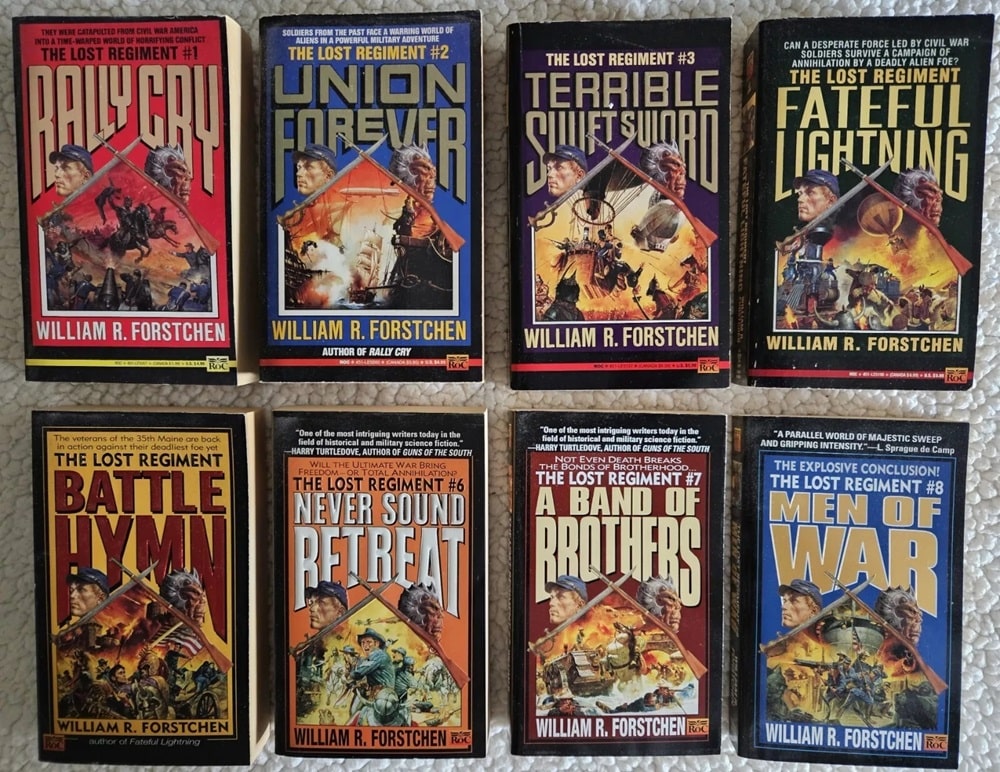 The Lost Regiment, by William R. Forstchen (Roc Books, 1990-99). Covers by Sanjulian
The Lost Regiment, by William R. Forstchen (Roc Books, 1990-99). Covers by Sanjulian
William R. Forstchen was born on October 11th, 1950, eight years and three days before my birthday. He earned a Ph.D. in history, specializing in the American Civil War, and teaches at Montreat College in North Carolina. He’s one of my favorite authors. He isn’t quite Sword & Planet but has a series that is adjacent with lots of S&P elements. It’s called The Lost Regiment and ran to 8 books. He later wrote a 9th book that took place 20 years after the end of the original series, but has not written any more.
All were published by Roc Science Fiction. Sanjulian is credited with the covers for books 6, 7, and 8, and if he did those I’m pretty sure he did all the previous ones as well, which clearly have the same style. However, book 9’s cover is credited to Edwin Herder. The Sanjulian covers are great but are quite small on the books and should have been larger.
[Click the images for regimental versions.]
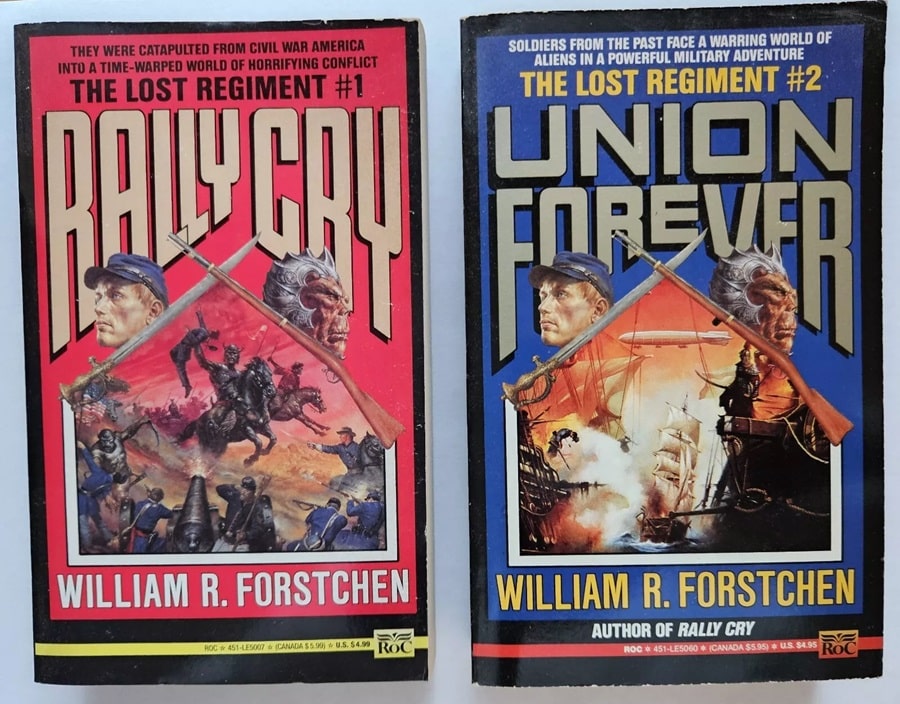
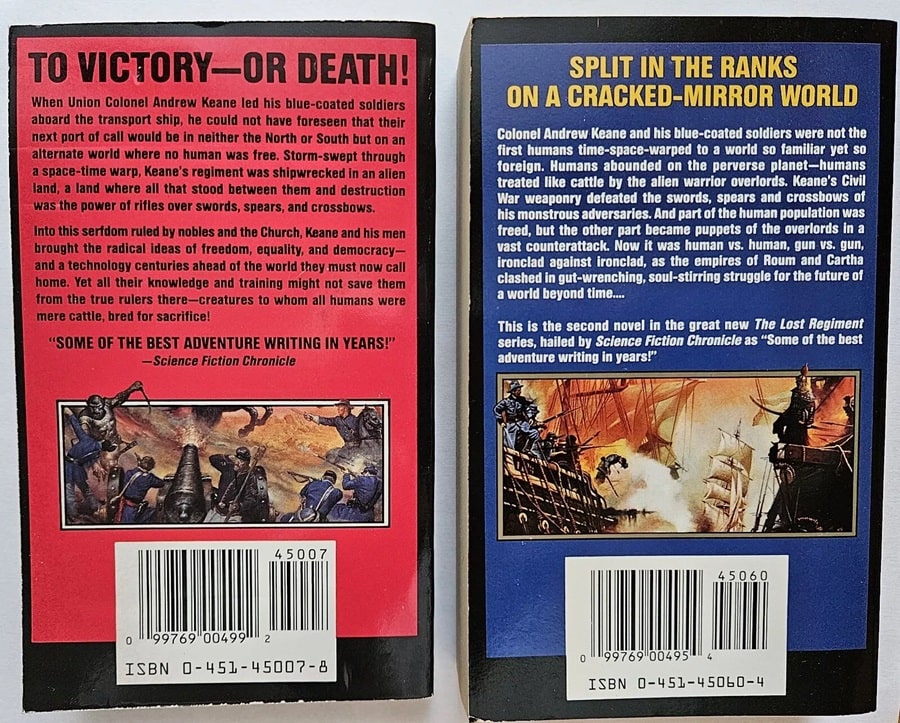
Rally Cry and Union Forever (Roc, May 1990 and February 1991). Covers by Sanjulian
The series consists of:
1. Rally Cry, 1990
2. Union Forever, 1991
3. Terrible Swift Sword, 1992
4. Fateful Lightning, 1992
5. Battle Hymn, 1997
6. Never Sound Retreat, 1998
7. A Band of Brothers, 1999
8. Men of War, 1999
9. Down to the Sea, 2000
Note: there are some mild spoilers ahead.
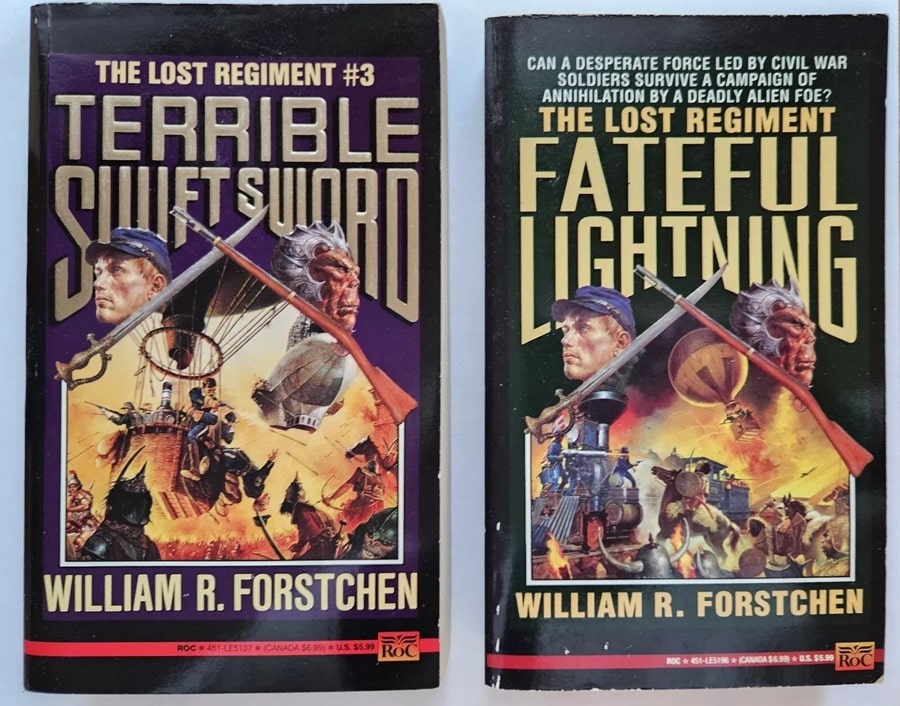
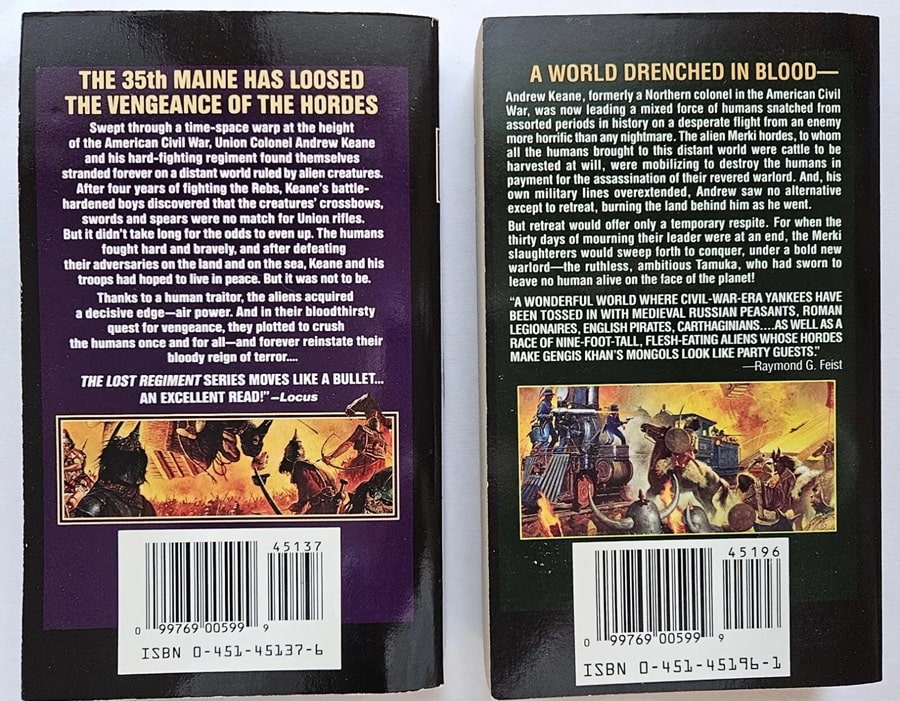
Terrible Swift Sword and Fateful Lightning (Roc, February 1992 and January 1993). Covers by Sanjulian
The first book, Rally Cry, starts out in good S&P fashion when two regiments of Union Soldiers from the Civil War board a transport ship to be taken to a battle against the Confederacy. While in the “Bermuda Triangle,” a storm hits and a tremendously bright light envelops them. They lose consciousness and wake up on another world, which they learn is called Valdennia. Other human groups have been previously transported to the world, including some Medieval Russians, Romans, and Carthaginians.
There is also an alien race of humanoids 8 to 10 feet tall and of massive build. These are called “Tugars” by most people, although we find out later there are different hordes of them. They are nomadic and ride huge horses bred from Earth stock, and use only primitive weaponry such as swords, lances and powerful bows. In fact, they reject anything resembling guns. The Tugars “eat” humans, and as they pass through the lands of human settlements they take a tithe of 20 percent of the people living there, but their territory is very large so they don’t pass too often. The Tugars also come from another world and it turns out their ancestors built the Light Gates, although the current Tugars don’t know how they work.
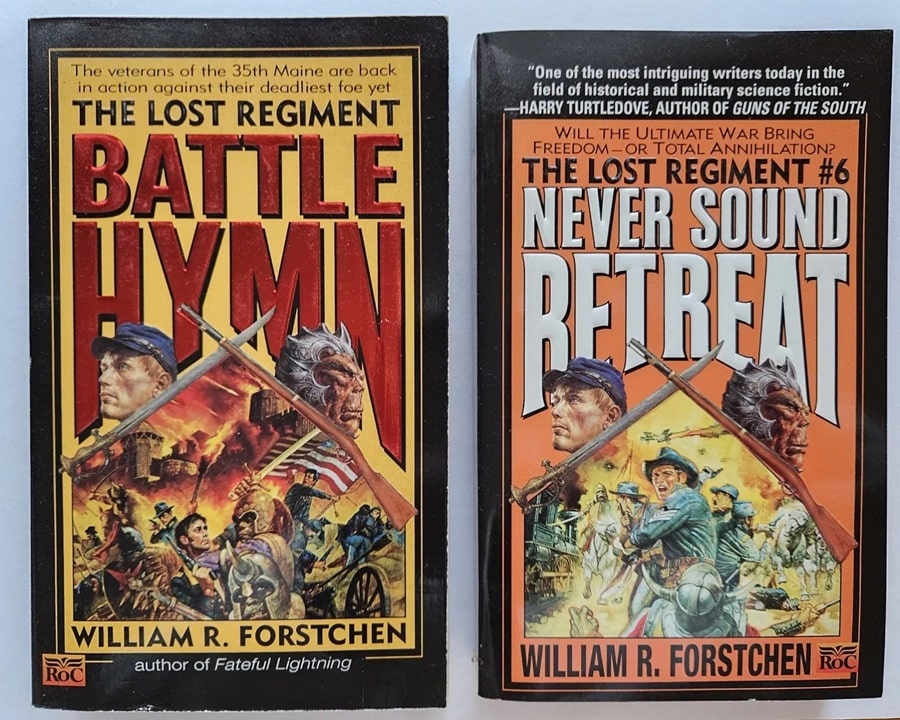

Battle Hymn and Never Sound Retreat (Roc, January 1997 and January 1998). Covers by Sanjulian
The series consists of the two Union Regiments allying with the humans of Valdennia to stop the horde. Their guns and cannon make a big difference and they decimate the Tugars. But then another horde, the Merki, step in, and behind them is a third horde called the Bantang. The Merki began to make use of gunpowder themselves and start to train human slaves to fight for them. The Union regiments and their allies must industrialize and advance in weaponry in order to survive.
These are thick books but scarcely a word is wasted. They are full of action and intrigue, but really have glorious battles. The characters are interesting and sympathetic. This was the first series like this I ever read, although a writer named Taylor Anderson, another historian, used the same concept in his Destroyermen series. I don’t believe these books would have existed without the influence of Sword & Planet works like ERB’s Barsoom tales.
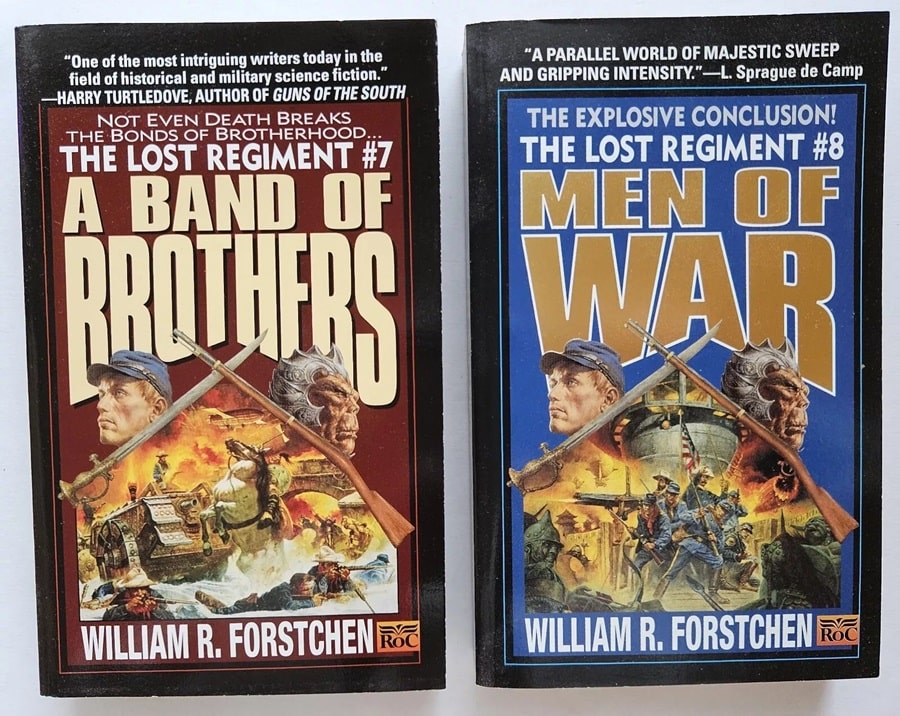
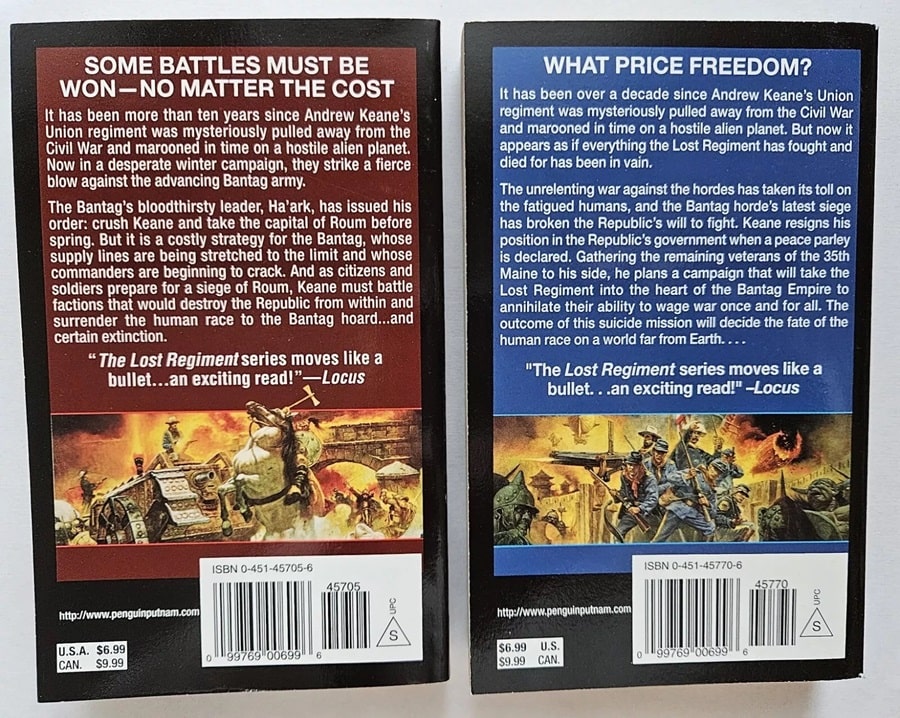
A Band of Brothers and Men of War (Roc, January 1999 and December 1999). Covers by Sanjulian
William Forstchen’s first book was published in 1983 and called Ice Prophet, with a cool cover by Darrell Sweet. It’s a post-apocalyptic fantasy set on a future, frozen Earth, similar to the setting for Michael Moorcock’s Ice Schooner. Rival religions rule the remnants of humanity but a new prophet arrives. There’s kind of a Dune vibe to the tale. It spawned two sequels but I haven’t read those. The book is good but it doesn’t have the quality of many of his later books. Forstchen’s clear strength is in using historical settings and historical types of characters.
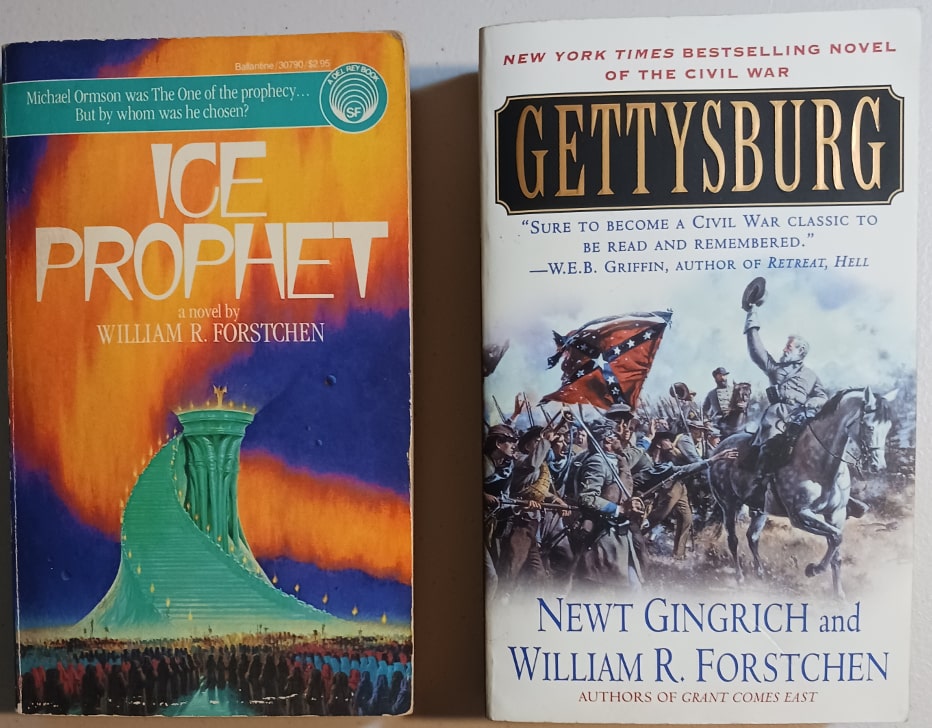 Ice Prophet by William R. Forstchen (Del Rey, August 1983) and Gettysburg by William R. Forstchen and Newt Gingrich (Thomas Dunne Books, June 2003). Covers by Darrell K. Sweet and Don Troiani
Ice Prophet by William R. Forstchen (Del Rey, August 1983) and Gettysburg by William R. Forstchen and Newt Gingrich (Thomas Dunne Books, June 2003). Covers by Darrell K. Sweet and Don Troiani
The next book I read from Forstchen after The Lost Regiment series was Gettysburg, (2003), which he wrote supposedly with Newt Gingrich. I personally don’t believe Gingrich had much to do with it. Everything in it seems to be Forstchen through and through, and there are even some characters and situations that are virtual rewrites of scenes from The Lost Regiment series. It was very good and there are two sequels that I will likely read at some point. Forstchen can really capture the heroism of men at war. The excellent cover is by Don Troiani.
He started a trilogy in 2009 with One Second After, followed by One Year After in 2015 and The Final Day in 2017. I actually suspect he meant the first book to be a standalone but it was so popular he came back to write two more some six years later. One Second After is one of the most memorable books I’ve ever read. I literally wept at the end.
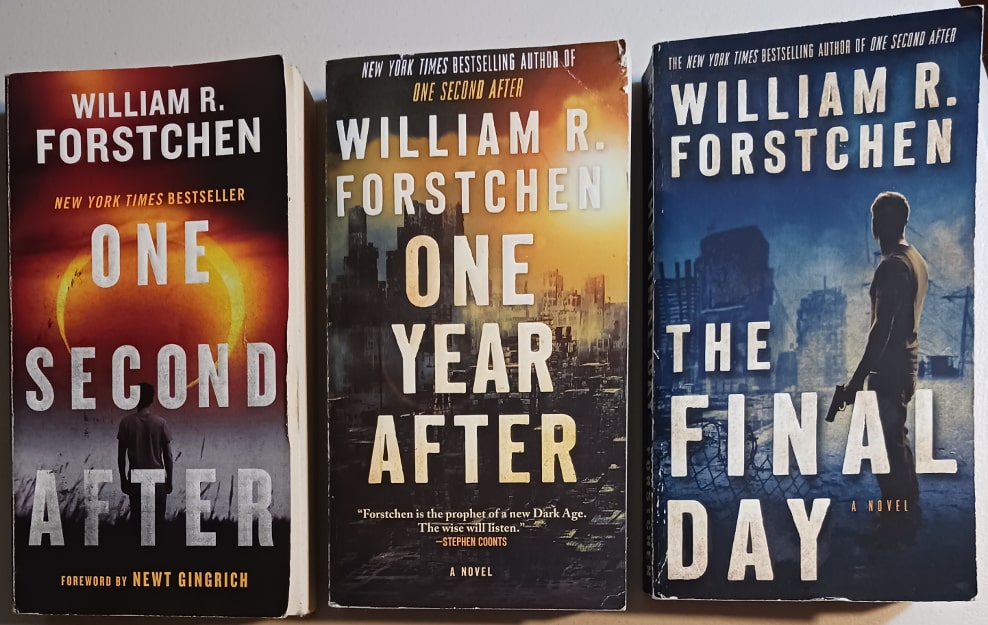 The One Second After trilogy: One Second After, One Year After, and The Final Day (Forge, March 2009, September 2015, and January 2017). Cover art: Trevillion and Thinkstock
The One Second After trilogy: One Second After, One Year After, and The Final Day (Forge, March 2009, September 2015, and January 2017). Cover art: Trevillion and Thinkstock
The two sequels are not as strong and are a little wordy in places, but they are still very good reads. The basic premise is what happens to a small town and its people after an EMP attack (electromagnetic pulse) on the US that wipes out all our electricity, bringing down our entire economy. This certainly isn’t the first time this kind of phenomenon has been used in fiction. S. M. Stirling’s Dies the Fire series posits a strange even that stops all electricity from working worldwide.
But Forstchen’s take is very well done and — I think — gives a pretty realistic, though perhaps optimistic view of what would happen. It chronicles the attempt by this one small town to hold onto their civilization and their humanity. One Year After looks back at the same folks a year later, and The Final Day takes place after a more general recovery has begun but is being corrupted from the inside.
Quite possibly because of his association with Newt Gingrich, who wrote the Foreword of One Second After, Forstchen has been criticized for holding overly right-wing views. After reading many of his books, I do believe that he is probably a political conservative, which I am not. However, his views seem nuanced to me. What he has created are very real seeming characters who hold certain conservative viewpoints. I know and get along with plenty of people who share such viewpoints and I would not consider them to be “right-wingers” in the pejorative sense of that word. Ultimately, these are good stories.
Charles Gramlich administers The Swords & Planet League group on Facebook, where this post first appeared. His last article for Black Gate was The Sword & Planet Fiction of Robert Moore Williams.
Goth Chick News: Celebrating Our 666th Black Gate Article with an Exclusive Announcement
 Dirk and yours truly, Chicago Comic and Entertainment Expo 2014
Dirk and yours truly, Chicago Comic and Entertainment Expo 2014
A couple years back, my long-time friend comic writer/creator Dirk Manning called dibs. He let me know that when the time came for me to publish my 666th article for Black Gate that he wanted to be my subject.
I first introduced Manning to all of you in 2011 during his nationwide tour promoting his horror comic series, Nightmare World. As a fan of horror comics since they were contraband for my young self, I loved how Manning’s work reminded me of everything I enjoyed about the genre. His most recent project has been a collaboration with the estate of legendary actor Lon Chaney to bring the lost classic horror film London After Midnight back to life in graphic novel form. Since 2011, Manning has made multiple appearances in GCN marking his many projects and his ever-growing fan base.
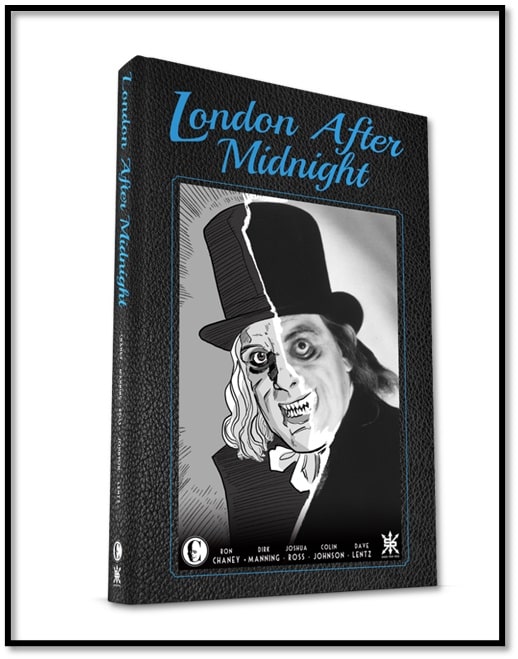 London After Midnight: The Official Graphic Novel Adaptation by Ron Chaney, Dirk Manning, Joshua Ross, and Colin Johnson (Chaney Entertainment and Source Point Press, 2025)
London After Midnight: The Official Graphic Novel Adaptation by Ron Chaney, Dirk Manning, Joshua Ross, and Colin Johnson (Chaney Entertainment and Source Point Press, 2025)
However, laying claim to a Goth Chick New milestone article would require a monumental announcement, and Dirk promised to deliver. Our agreement included holding this news until early January 2025 due to various NDAs, which in turn meant a lot of leeway from BG Big Cheese John O allowing me to skip writing on various weeks throughout 2024, enabling my 666th GCN to align with Dirk’s timing.
So, without further ado, allow me to present Goth Chick News’ 666th article for Black Gate Magazine.
Buckle up readers, here we go…
 Dirk Manning
Dirk Manning
GC: We are sitting with Dirk Manning and Josh Malerman, New York Times best-selling author of Bird Box and Incidents Around the House for an exclusive about their upcoming collaboration. Tell us how you came to partner up for this exciting new graphic novel RSVP E.S.P.?
DIRK MANNING: Thank you so much for allowing us to give you this Black Gate exclusive interview about this project! We’ve both been waiting to be able to talk about this new graphic novel for a while now! As for how it started, I first met Josh Malerman after a mutual friend at the time foisted a copy of Bird Box into my hands, citing that he thought it would be up my alley as a fellow horror writer. This was back in late 2015, well before the movie and the following cultural phenomenon surrounding it had happened, so I went into it fairly blind, intrigued by the Lovecraftian concept of a creature that drove you mad the moment you made eye contact with it. Well, once I started the book, I legitimately had a hard time putting it down, and upon finishing it I was so blown away that I circled back and asked if I could meet Josh, just to tell him face-to-face what a fan I was of the book. I was genuinely already a super-fan, ha-ha! The meeting happened over a hot dog and tacos dinner on February 12th, 2016, and I immediately became a fan of Josh as a person that night, too… and we’ve remained both colleagues and pals ever since.
 Josh Malerman
Josh Malerman
JOSH MALERMAN: The older we get (and none of us are that old), the more I understand how rare it is to become immediate friends with someone. Not because any of us are so cynical, but because we’re busy, because we have friends, because we have passions and we’re spending so much time with those. But when it does happen, when you cross paths with someone who is either in your field or doing what they do for the same reasons you are… it’s impossible to miss. I think it took all of ten seconds for me to recognize an immediate friend and like-minded soul in Dirk Manning. The way he presented himself, his work, the people in his life… his sense of humor, his tastes, his intelligence… it was all on display in everything he says. I knew right away I wanted to work with him on something. What that was wouldn’t present itself for a minute… and once it did, it was clear as day.
DIRK: Fast forward to September 2022. By this point Josh had released several more books and had achieved well-earned superstardom as one of the best horror novelists of this generation (at least), and I had recently taken a position as Special Projects Manager with Michigan-based comic publisher Source Point Press. This meant, along with publishing my own creator-owned work, I was shepherding projects with various high-profile talents outside the world of comics, such as musicians Twiztid and Blaze Ya Dead Homie and professional wrestling personalities Tony Schiavone and Arn Anderson… so the idea of bringing Josh Malerman into the fold in a similar fashion was of course a no-brainer to me. Well, Josh always does these cool book release party events for his novels, and for Daphne the event was taking place on a high school basketball court since the main character was a high school basketball player. How cool, right? Given the setting – and despite my lack of sport skills – I decided to ‘shoot my shot’ on this, asking him – literally on the court in front of the hoop (where we was nailing several free throws, I might add), ‘Hey, have you ever thought about writing a graphic novel?’ Without missing a beat he immediately fired back ‘Only if you’ll write it with me.’”
 Bird Box (Ecco, February 10, 2015)
Bird Box (Ecco, February 10, 2015)
JOSH: I have a long history of collaborating with my fellow bandmates in The High Strung. For years now, Mark and I write the songs, then we hand them over to the band and they make their music. We don’t tell them what to play. That would be counterintuitive to everything fun about the process. When the movie Bird Box was made, I felt I’d written the song (the book) and then Netflix and Sandra Bullock made their music. Fantastic. Perfect. So! When Dirk asked about working on a graphic novel, I immediately thought: “omg yes.” I had a story idea that I hoped would work, we talked about it some, and then Dirk… well, then Dirk made his music.
DIRK: After mulling things over a bit, Josh presented me with a story idea originally titled Two Gods in the House (and since renamed RSVP E.S.P. – which is a story in itself for another time, haha!) about a scientist who invites two potentially psychic children into his house to prove the existence of psychic powers… not realizing how powerful they really are or what he’s in for by doing so. He expressed to me that, while he loved the story (and rightfully so, as it was amazing) that he couldn’t quite make it work as a prose novel. Upon reviewing everything he gave me, I told him what I saw as both an obstacle and an opportunity: “I can see why, dude: This is a story that needs to be told visually.”
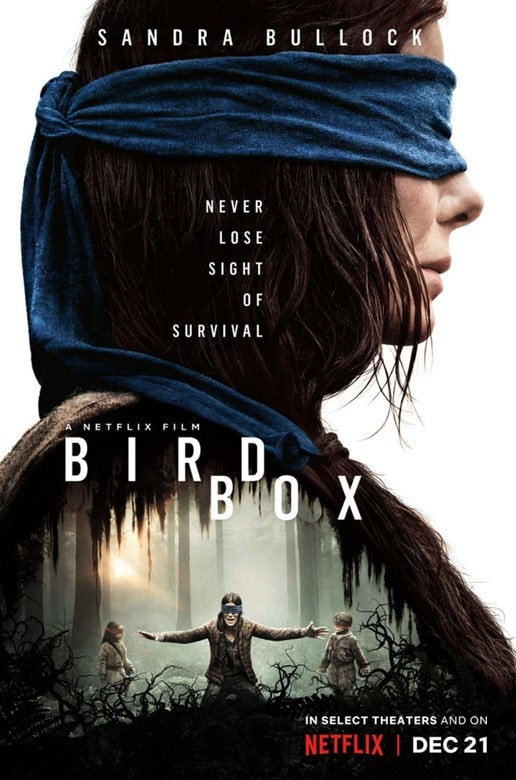 Bird Box (Netflix, December 14, 2018)
Bird Box (Netflix, December 14, 2018)
JOSH: I think it took somebody who worked in a more visual field to point out to me that RSVP E.S.P. was born to be a visual story. Everything about it was cinematic, to be seen, to be felt, and I’d been wrestling with it on a description level for that very reason. Think of your favorite scenes in a movie, the ones that move you to tears… often they are a simple change in somebody’s expression, a change in light, a change in color. Dirk saw this straight away in the story. He knew the arc, the peaks, the rhythm… but also… he knew the illustrator. This led to an incredible night at my house, in which Dirk, illustrator Joshua Ross and myself essentially cut the ribbon, slammed the shovel into the ground… we broke ground that night on the graphic novel. It was absolute magic.
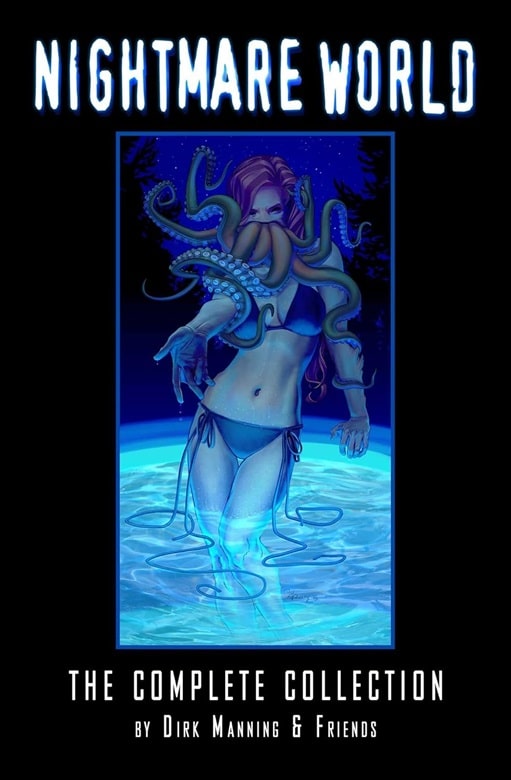 Nightmare World: The Complete Collection (Source Point Press, May 21, 2024)
Nightmare World: The Complete Collection (Source Point Press, May 21, 2024)
DIRK: From the beginning of the process, I knew only one illustrator could possibly do RSVP E.S.P. justice as a graphic novel, and that illustrator was Joshua Ross. Joshua had been one of my longest artistic collaborators in comics for my 20+ year career, stemming all the way back to the earliest days of Nightmare World and then being the artist I chose to work with to launch Tales of Mr. Rhee. Eventually Joshua stepped back from comics for a bit to work on the launch of his tattoo studio Raygun Samurai, but we still did occasional comic work together. Then in 2020 he wrote and fully illustrated his own first graphic novel Left Turns, which went on to be published by Source Point Press and also earned a Publishers Weekly review. As he finished that book I reached out to him and said “Listen, I can’t tell you any specific details yet, but I’m going to be involved with working on a graphic novel with a #1 New York Times Best-Selling horror author, and you’re the only person I know who would be able to illustrate this story. Would you be willing to jump back into doing a full graphic novel together for this one?’ To his credit, Joshua said “I trust you and I’m in” and that was that. I then brought in colorist Colin Johnson and letterer Dave Lentz, both of whom I’d worked with on Homestead as well as my longtime graphic novel editor Drena Jo, solidifying our team… and then the work on bringing RSVP E.S.P. to life as a 120 page graphic novel began in earnest!
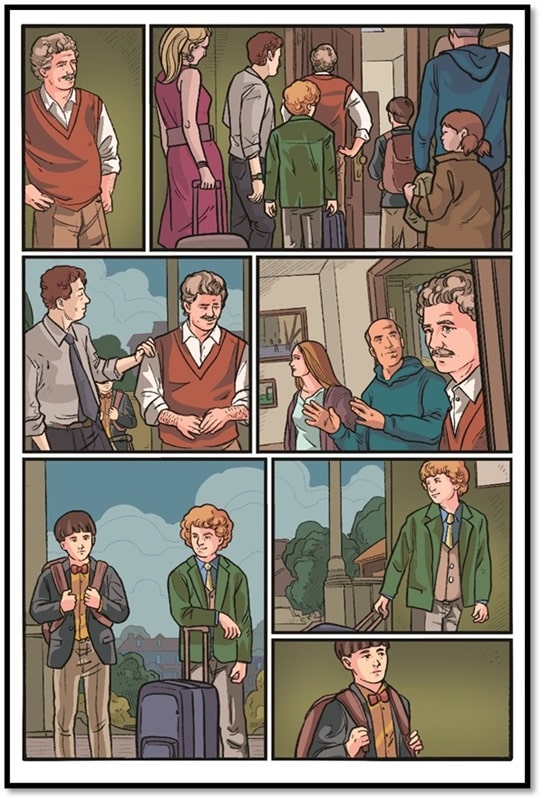 First look at unlettered art from the RSVP E.S.P. graphic novel
First look at unlettered art from the RSVP E.S.P. graphic novel
JOSH: I know I’m a writer, and I know I’m supposed to be able to articulate how I feel by nature, but it’s hard for me to express how far RSVP E.S.P. has surpassed my expectations. I was happy to be working with these people at all. But to watch them each take their turn (Dirk with writing, Joshua with illustrating, Colin with coloring) was like watching the best people at their best. It’s the reason I love collaboration in the first place: it’s not the pressure of wanting to live up to those around you… it’s the inspiration you get from them, the wind tunnel you all create together, the crest that only exists because you all said yes.
DIRK: The book is now fully illustrated and colored, lettering is about to begin, and we’ll be doing a presale launch on Kickstarter in February or March for a Limited Edition Kickstarter Exclusive Hardcover of the graphic novel before we then solicit a standard softcover edition through mass market retailers after that. Details on the upcoming release will be shared on my Instagram, Facebook, and BlueSky accounts at @dirkmanning as well as through my monthly newsletter which people can subscribe to at www.DirkManning.com.
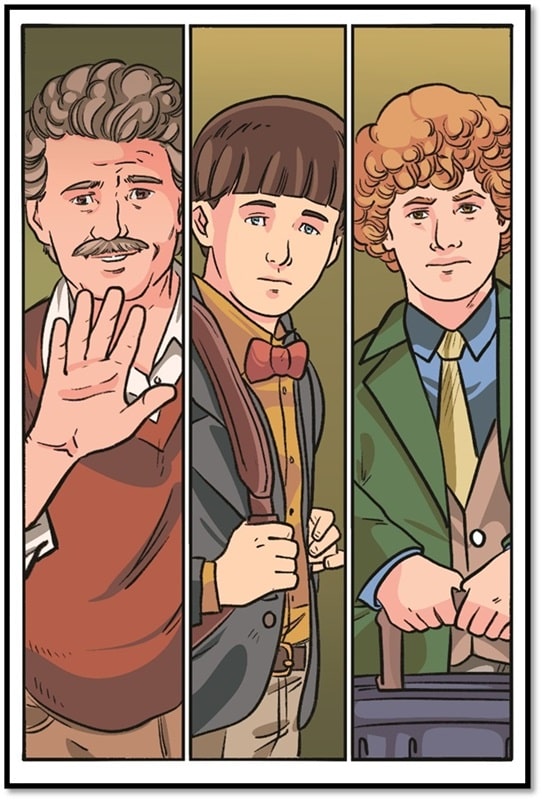 First look at unlettered art from the RSVP E.S.P. graphic novel
First look at unlettered art from the RSVP E.S.P. graphic novel
JOSH: RSVP E.S.P. has been one of the greatest artistic experiences of my life. I simply cannot wait for this to come out. For the world to hold it, to slip into the story of a doctor who has no idea the power that exists in his home and lab. I’m sure I’ll be talking about it all very soon on Facebook and Instagram (I’m just @JoshMalerman at all places online), as well as my website joshmalerman.com.
GC: Thank you both for dropping the news of this exciting project at Black Gate. We’ll be looking out for more in the coming months and hope you’ll sit down with us again near your publication date.
More of Dirk’s comic work includes Butts in Seats: The Tony Schiavone Story (a #1 Best-Selling Graphic Novel on Amazon), Buried But Not Dead (Ringo Award finalist for Best Original Graphic Novel in 2021), Twiztid Haunted High-Ons (Ringo Award finalist for Best Humor Comic in 2020 and 2022) among many others. He is also the author of the inspirational/how-to column turned book series Write or Wrong: A Writer’s Guide to Creating Comics and has contributed several short stories to the RPG game series Clockwork: Dominion for Reliquary Game Studios. His screenplay writing credits include the YouTube horror series BlackboxTV episode “The Hunger” directed by Drew Daywalt and featuring Bonnie Aarons (The Nun, I Know Who Killed Me) and Jon Gries (Napolean Dynamite, Men in Black).
When not at his desk writing, touring the comic convention circuit, and/or sampling his way across the best ice cream shops in the world, Dirk can be found online at www.DirkManning.com and on most social media platforms as @dirkmanning.
In addition to being a best-selling author, Josh Malerman is also one of two singer/songwriters for the Michigan rock band The High Strung, whose song “The Luck You Got” can be heard as the theme song for the Showtime show Shameless. He loves endless, enthusiastic conversations, shooting pool, and thinks Freddy Krueger is the most brilliant monster ever created. He lives in Michigan with his fiancée, the artist/musician Allison Laakko and their five hundred pets.
I would like to personally thank all of you for checking in on Goth Chick News each week and leaving your wonderful and beautifully sarcastic comments over these many years. I look forward to reading each one – especially the regulars. I must also give a shout to Black Gate Photog Chris Z who joined me for the first time in 2012 and whose hysterical snark has almost (but not quite) gotten our press credentials revoked on more than one occasion. And finally, my continual gratitude to Black Gate Big Cheese John O who first published me in Black Gate’s second print issue and whose encouragement turned this quirky side-hustle into a 20+ year passion.
Hal Clement Helped Launch My Writing Career
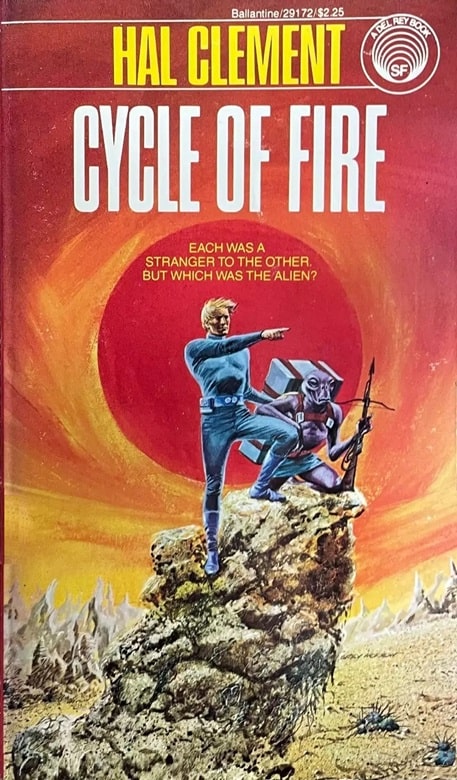
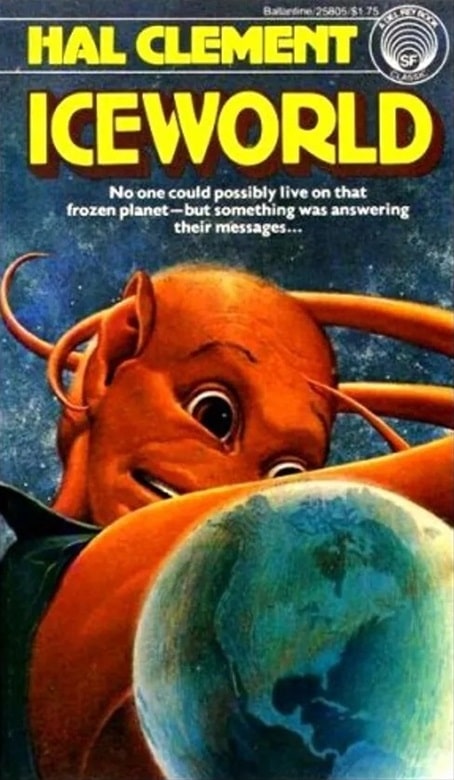
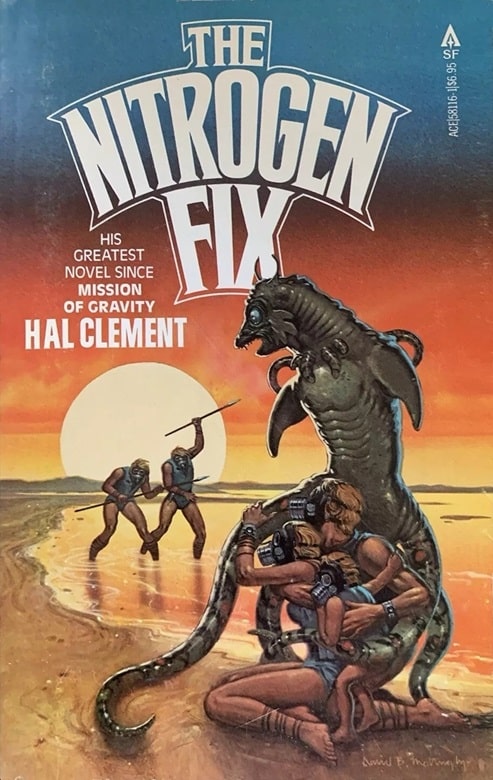
Novels by Hal Clement: Cycle of Fire (Del Rey, February 1975), Iceworld
(Del Rey, October 1977), and The Nitrogen Fix (Ace Books, September 1980).
Covers by Gray Morrow, H. R. Van Dongen, and David B. Mattingly
Hal Clement (real name, Harry Stubbs) was born in 1922 and passed away in 2003. He graduated from Harvard and held degrees in astronomy, chemistry and education. A former B-24 pilot, he worked for most of his life as a high-school science teacher at Milton Academy, in Milton, MA. He gained his reputation as a writer of hard science fiction, a pioneer of the genre. I have read his novels The Nitrogen Fix and Cycle of Fire, both of which I enjoyed immensely.
I got to meet Hal at a sci-fi convention about 30 years ago. I was a struggling young writer in my early 20s, working hard on a science fiction novel modeled in the styles of Edgar Rice Burroughs and Sir Arthur Conan Doyle. Hal was part of a panel discussion on how to break into the writing business. His fellow panelists were comprised of some Star Trek novelists and editors. I was thrilled to attend the panel; with all the youthful exuberance one could imagine.
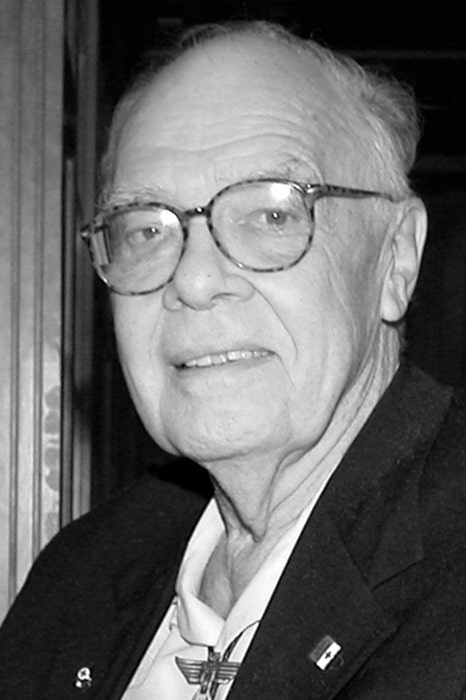 Hal Clement
Hal Clement
After the panel discussion was through and people were milling about, I approached the group of panelists, including Hal. I had five or six manilla envelopes, each containing the first few chapters of my novel. Frightened, yet determined, I introduced myself and asked the panelists if any of them would be willing to take a look at the first few chapters of my book and, if they were so inclined, let me know what they thought of it.
This offended one of the Star Trek novelists (or editors, wasn’t sure), and she tore me down, berating me, telling me that asking this of them was grossly inappropriate, in bad form, and completely unprofessional. Her peers were shaking their heads at me, in agreement with her assessment of my solicitation.
Except for Hal. As the Trek writers and editors walked away, leaving me stunned, Hal said to me, “I’d like to take a look at it.” I was happy but still upset that I’d committed some kind of inexcusable writer’s faux pas, so I awkwardly thanked him and walked away.
I never heard back from Hal, which is fine, but about an hour or so later, walking about the con, I saw him again, sitting in a chair, reading my manuscript.
That gave me hope to keep going, to keep writing. It meant a lot to me then, and it still does to this day.
Jeffrey P. Talanian’s last article for Black Gate was From Al-Qadim to The East Mark Gazetteer. He is the creator and publisher of the Hyperborea sword-and-sorcery and weird science-fantasy RPG from North Wind Adventures. He was the co-author, with E. Gary Gygax, of the Castle Zagyg releases, including several Yggsburgh city supplements, Castle Zagyg: The East Mark Gazetteer, and Castle Zagyg: The Upper Works. Read Gabe Gybing’s interview with Jeffrey here, and follow his latest projects on Facebook and at www.hyperborea.tv.
Reading Leigh Grossman’s Sense of Wonder, the Longest Science Fiction Anthology Ever
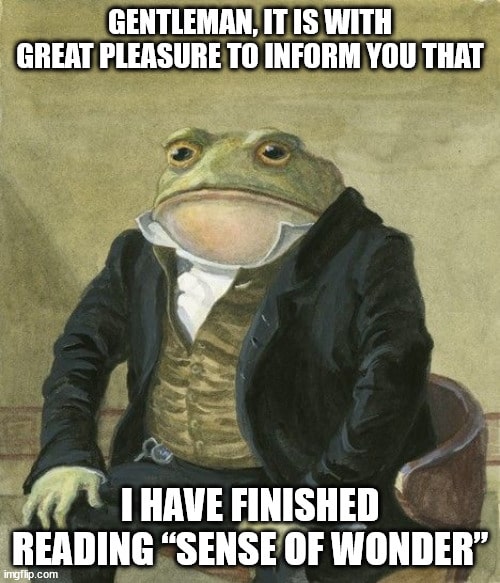 I have finished reading Sense of Wonder
I have finished reading Sense of Wonder
Having just finished reading arguably the longest anthology of science fiction, I’ve written down some notes and thoughts.
TL;DR It’s an insanely long book, worth buying but not necessarily reading cover-to-cover.
About the BookSense of Wonder: A Century of Science Fiction, edited by Leigh Grossman, is a massive single-volume anthology of science-fiction. Don’t be fooled by the 992 print pages because that is with a tiny font. I read the Kindle version for which Amazon gives an average reading time of 140 hours. That is about 5 times as long as Cryptonomicon by Neal Stephenson (itself a 1,200 page door-stopper). All in all, a huge dose of SF.
The book is classified and marketed as a textbook for teaching SF courses and rightly so. Besides over 150 stories (from short stories to novellas), it contains biographical entries about each author and additional essays about related topics. The appendices give advice to aspiring authors on writing and submitting SF stories.
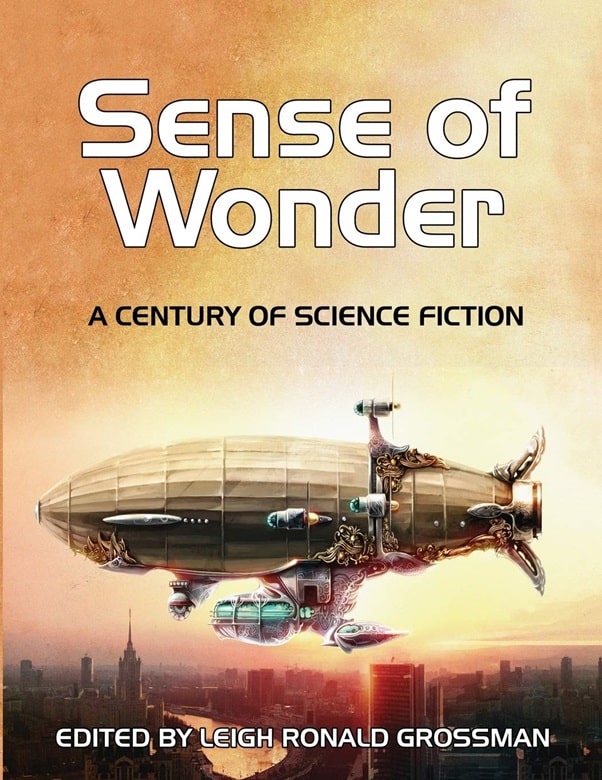

Sense of Wonder: A Century of Science Fiction (Wildside Press, June 1, 2011). Cover art uncredited
In terms of content, Sense of Wonder includes whole “books” like A Princess of Mars by Edgar Rice Burroughs and The Time Machine by H.G. Wells, both from The Classics of Science Fiction – Novels v5 list. It also has at least 34 entries from The Classics of Science Fiction – Short Stories v2 list. Apart from poems, each author appears with only one entry (story).
My OpinionThis book is a bargain! I bought it for $30 and definitely got my money’s worth in terms of content.
I wish it were more of a “best of” anthology. It comes close to that (as evidenced by the number of entries from the Classics list), but in some cases stories were unavailable or the authors had other suggestions. Here’s an example from the editor’s text:
Although he’s best known for his alternate history, when I contacted him about a contribution for this book, Turtledove correctly pointed out that I already had plenty of alternate history in the book, but sorely needed a baseball story.
The essays, each by a different contributor, were generally good, often discussing themes appearing in preceding stories. Some were quite academic (those went over my head) and one was so badly written I’m surprised it got included.
I also wish that the book was less American-centered. Not only in the way information is presented, but also in the selections. There are some by British, Canadian and Australian authors, but other than that only two stories are translated from foreign languages.
NotesI started reading this book in 2001, but at first, I jumped from story to story as I was finishing reading the Classics of Science Fiction – Short Stories v2 list.
Then, halfway through 2024, in an ongoing effort to clean out unread books on my Kindle, I started going through it from the start. I omitted what I had already read, so that helped. To further improve my progress I looked for audio versions of the stories (with a success rate of about 20%).
This lead me to some great finds, such as the production of Terry Bisson’s “They’re Made Out of Meat” by the This American Life podcast. I made a spreadsheet for each story (whether I’d read it before and whether it’s available in audio anywhere) and included a brief review. Filling out the spreadsheets was part of the appeal of this reading challenge.
Favorite StoriesApart from those that appear on the Classics list (and which we know to be good), I gave 5 stars to these stories.
- “Dogwalker” by Orson Scott Card — Great theme (cyberpunk, cracking passwords), fun style, and great audio narration all made this story kick!
- “Soldier, Ask Not” by Gordon R. Dickson — Awesome story of military conflict, loss and revenge. Noticeably well written!
- “Rat Race” by Frank Herbert — Great, like a precursor to X Files.
- “Good with Rice” by John Brunner — Wonderfully written story about modified food set in China.
- “For I Have Touched the Sky” by Mike Resnick — Great Kiringaya story about freedom and choosing the lesser evil.
Of course, there were also stories which I didn’t enjoy, but that’s inevitable with such a large collection.
If you’re interested in short form SF, I would recommend buying Sense of Wonder and starting out by reading the 34 stories already identified as among the best in the field.
The Public Life of Sherlock Holmes: Death (of a Detective) in Paradise
 And we kick off 2025 with the return of the column that earned me regular gig here at Black Gate. I’m ostensibly the in-house mystery guy around here, though I’m way beyond all over the place. Death in Paradise is a police procedural (it is not, however, a buddy cop show) with a fair amount of humor, and it debuted on BBC1 on October 25, 2011. The show started airing a Christmas special a few years ago, and episode number 109 just aired on December 22, 2024.
And we kick off 2025 with the return of the column that earned me regular gig here at Black Gate. I’m ostensibly the in-house mystery guy around here, though I’m way beyond all over the place. Death in Paradise is a police procedural (it is not, however, a buddy cop show) with a fair amount of humor, and it debuted on BBC1 on October 25, 2011. The show started airing a Christmas special a few years ago, and episode number 109 just aired on December 22, 2024.
The basic premise is that Scotland Yard assigns a DCI (Detective Chief Inspector) to duty on the island of Saint Marie (pronounced ‘San Marie’), located in the Lesser Antilles. Saint Marie was turned over to the British by the French roughly forty years before the show starts. So, it still has a French-Caribbean culture.
There is a four-person police unit, with the DCI (Richard Poole) joined by a local Detective Sergeant (Camille), and two local uniform ‘beat cops’ (Dwayne, and Fidel). There are two other regulars: the female owner of a local bar (Catherine, who is Camille’s mother), and the Police Superintendent (Patterson). Five of the six main characters are island natives, so this is a classic fish-out-of-water scenario.
DCI Richard Poole is played by Ben Miller, who was great as Rowan Atkinson’s competent helper-agent in the Johnny English spoofs (the first one is a classic). Miller refuses to take off his jacket or loosen his tie while barely enduring the heat: Stiff upper lip and appearances and all that. He’s constantly miserable, and I love him in the part.
Episodes are an hour long, and the plots are complex. The fictional Saint Marie is near the real-life archipelago (isn’t that a fun word?) of Guadeloupe, which is where it’s actually filmed. The island and its culture are as much a fixture on the show as the actors are.
MINI SPOILER!!! – Just move down to the next paragraph if you don’t want to learn something about the cast. You have been warned.
This show changes cast members more frequently than the Pittsburgh Steelers win a playoff game (though that ain’t saying much). The four main police characters turn over nearly a dozen times. With one notable exception, the new characters brought in work well. Nine actors have appeared in at least 30 episodes (which is about three-plus seasons). Two more actors should break that mark in 2025. So, you get attached to a character at your own risk.
END SPOILER
I think that this is a terrific police show. The British DCI, the local officers, the island setting – it all works. Seasons are short in the typical British fashion (the idea of a 26-episode season must put British TV-makers in shock). It’s also one of several British dramas that has taken to airing a one-off Christmas episode (sometimes sort of a mini-preview of the upcoming season), and I look forward to this one every year now.
BritBox has all seasons, and I recommend going back to the pilot and watching from the beginning. It’s worth every minute.
HERE BE DRAGONS! (and Spoilers)
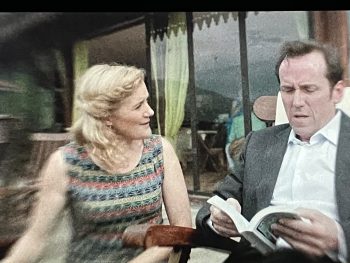 If you haven’t seen the first two seasons, and this episode, you should probably stop reading this, if you plan to do so. There’s a major cast change in the opener of this episode. I wouldn’t want to ruin the surprise. Read on at your peril.
If you haven’t seen the first two seasons, and this episode, you should probably stop reading this, if you plan to do so. There’s a major cast change in the opener of this episode. I wouldn’t want to ruin the surprise. Read on at your peril.
Since the episode is titled Death of a Detective, you might be able to guess what happens. The actor playing the British DI of the moment spends a significant part of their year in Guadalupe, filming. Ben Miller (DI Richard Poole) wanted to be back home in England. It was rumored he would be leaving after season two. The season finale had him escorting a prisoner back to England, and Camille was certain he couldn’t resist remaining there. It looked like he was off the show, but he reappeared at the very end of the episode.
So, I was excited to see him start off the next episode. I thought he would be around for at least one more season. Except, in the first segment, they found him on a chaise on the deck at a college reunion party on the island; with an ice pick in his chest. They killed him off!!! This episode still is a kick in the nuts for me. When they show the body; and there’s a silent, slow-mo montage with the other police there with the body. It’s a really powerful scene.
Now, they set the tone for main characters of the show in the pilot, with two main characters being removed (this wasn’t recasting after testing the pilot – it’s plot). But Poole had been the center of the show for the first two seasons, and I took this as quite a blow.
So we will move on from DCI Richard Poole, but his death scene remains etched in my TV-viewing memory. Don Warrington plays Commissioner Selwyn Patterson. He’s the boss, though he mostly runs things from afar. He sometimes weighs in with the ‘political and social realities’ of things. He’s rather humorless, and he isn’t enthralled with misfit Scotland Yard inspectors, but he’s a good guy overall, if rather stiff.
He comes into the station and we meet Poole’s replacement, DCI Humphrey Goodman, played by Kris Marshall. Humphrey is a different kind of fish out-of-water. He takes awkward to nearly epic levels. His first scene, arriving at the Honore police station in a cab, as the Commissioner and team watch him from the portico, really captures his essence.
There’s a really well-done scene in which he walks over to Richard’s empty desk and says “Uh. This is me, is it?.” It’s set apart, and kind of ‘looks out over’ the rest of the room, including the other three officers’ desks.
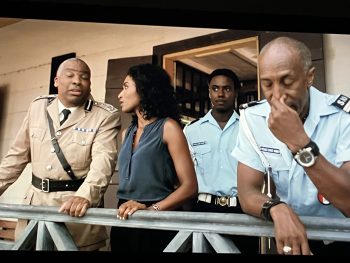 He stops and looks back as they watch him. Clearly seeing another DI about to sit at Richard’s desk is raw at this point. The scene is extended for a second or two and it’s quite poignant.
He stops and looks back as they watch him. Clearly seeing another DI about to sit at Richard’s desk is raw at this point. The scene is extended for a second or two and it’s quite poignant.
He clears his throat awkwardly a few times (everything about him is awkward, constantly), and instead walks to a small desk at the far side of the room. He sits down and says, “Actually, this will be great.”
The chair clicks down and you can only partially see him behind his bag on the desk. He lifts it back up and sits there…yes, awkwardly. I’m not over-emphasizing this, trust me. The team is clearly not impressed with this introduction.
But we have absolutely captured the essence of Humphrey. You’ve got the awkward part by now. Both physically and we’re guessing, socially (though Richard was reserved British socially inept). He’s thoughtful and not brash. He won’t be aggressively confronting suspects. His good nature is built on throughout this episode. The Commissioner has said that London touts him as a good detective, and we will see about that shortly.
Humphrey is constantly looking in his pockets for some scrap of paper to take notes on. I recall he is given a notebook or has one a time or two, but it simply doesn’t work for him. Early on, he pours the coffee out of a cup, flattens it, and starts taking notes on the cup. It is odd to watch. It’s a little thing, but it’s so him.
Fidel and Dwayne try to give him the benefit of the doubt. It’s not easy to do, as Humphrey tries to sit on a ledge at the crime scene and falls out the window while talking!
As the scene ends, with a disapproving look on his face, Dwayne says “Am I seeing things, or did he fall out of the window?”
Fidel looks resigned and says “Yes. Yes he did.” Dwayne shakes his head and walks away. A little later, Dwayne is complaining about Humphrey, and Fidel is telling him that Richard would want them to give him a chance. Even though Fidel is trying to get around how unimpressive the new man has been.
Camille wants nothing to do with him, and she’s a far cry from friendly. The next scene is Humphrey and Camille walking on the beach, and Humphrey can’t stop uncomfortably talking, and being a goober.
He finally says, “You really don’t want me here do you?
“No.”
Humphrey stops walking. “I’m not here to take his place. I’m not here to be him. I don’t expect anything. Any consideration. I’m just here. And while I’m here I promise I will do everything I can to find out what happened to your friend. ‘Cause that’s what he was. Not just your colleague. I’m sorry for your loss. I truly am.”
It’s sincere, and he may be a goober, but we like him. It’s impossible not to.
“But the thing is, I have a feeling I may need some help, and a great deal of it. You can decide if you like me afterwards.”
Camille is not exactly thawing. “And if I don’t?”
Humphrey has a good smile, which even conveys self-deprecation. “Good point. I don’t even have an answer for that.”
He looks down and sees that the surf has come up and his shoes are immersed. It fits his lack of ‘cool’.
“There’s a whole list of things I’m not very good at. But, I am a good detective And right now more than anything, I want to catch the person who murdered your friend. So maybe, just for now, it’s enough that we both want the same thing.”
Camille is looking at him like a surly teenager who has to listen to a parent. But she looks down and says You’re wet”
“Yes I am.”
“Your shoes will dry as we walk.” She says this with maybe the slightest hint of a smile (I’m honestly not sure), turns, and they go on.
 There’s a lot of humor around the British CDIs not fitting in. Though one, who is Irish, actually seems like a rather normal person! But this episode really leverages the emotional impact of Richard’s death, in multiple ways. This is a pretty compelling scene that helps us adopt Humphrey quickly.
There’s a lot of humor around the British CDIs not fitting in. Though one, who is Irish, actually seems like a rather normal person! But this episode really leverages the emotional impact of Richard’s death, in multiple ways. This is a pretty compelling scene that helps us adopt Humphrey quickly.
The assigned CDIs have their different hangups. Along with a marked SUV, the other official vehicle is a motorcycle with a sidecar. Dwayne drives. Richard hated being in the sidecar. But Humphrey finds it “splendid.” This just makes Dwayne shake his head.
If you follow me on FB, you know that I periodically play ‘I Know that Actor,’ where I snap a pic of some actor I know from another show or a movie. I started this years ago with all the great cameos on Columbo. And I do it with shows like Pysch, Monk, and other episodic ones I watch. Murdoch Mysteries is great for Canadian actors, and I do it with Death in Paradise. In this episode, one of the four suspects is Helen Baxendale. She was’ Ross’ British wife Emily, on Friends. She also had the lead on Curtain, the final Hercule Poirot story. I’ve talked about the FANTASTIC series with David Suchet, here.
I’m not going to give away the solution. This is one of those shows where the main detective solves the case without revealing anything, and the suspects are then gathered together for the denouement. This was established with Richard, but Humphrey is put off by the approach. “In front of everyone??” He doesn’t want to do it, but he likes it!
The solution reveals that Richard’s keen intellect, observational skills, and ability to solve a puzzle, led to his murder. It’s a nice farewell to the show’s star.
They actually brought Miller back for a sort-of-dream sequence, in season ten, as he gives advice to a character. It’s a very low-key, powerful scene. I only picked up on one neat element when I re-watched these first two seasons.
Back at the station, Humphrey finds his desk bare. He’s puzzled, looking for his stuff. Camille has set him up at Richard’s old desk. He is the new DCI. It’s nice closure. Humphrey does not join the gathering at the bar. He feels an intruder as they say goodbye to Richard in their own way. He takes a taxi home, but he and Camille have a bond.
The show ends with a voice mail from his wife, who is still behind in England wrapping things up. She is divorcing him. This episode has packed SO much emotion in one hour, from start to finish.
Marshall would stay on the show for three seasons, before the inevitable casting change. I’m not exaggerating when I talk about the turnover. The latest DCI was introduced in the new Christmas special.
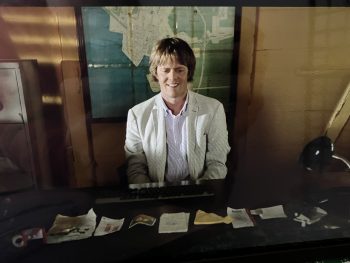 In 2023, a new spinoff show was created, Beyond Paradise. Humphrey is in Devon (Southwest England). He’s still ‘himself’ (another fitting opening scene). The show is as much about his relationship with his girlfriend, as about the crimes. I like it well enough, and it’s been renewed for a third season (they just had a new Christmas special), but I’m not that invested in it.
In 2023, a new spinoff show was created, Beyond Paradise. Humphrey is in Devon (Southwest England). He’s still ‘himself’ (another fitting opening scene). The show is as much about his relationship with his girlfriend, as about the crimes. I like it well enough, and it’s been renewed for a third season (they just had a new Christmas special), but I’m not that invested in it.
I NEVER solve the case on Death in Paradise (which i always a murder, I believe). It’s always convoluted. I think they do a decent job with fair play, but I don’t even try to figure it out anymore. I just enjoy the show.
Series creator Robert Thorogood wrote three Death in Paradise novels, set in the Richard Poole era. I just finished the first, and started the second. They’re okay. No surprise that he has the characters down, and he plays out Richard’s characteristics and his hating living there. But they read slooooow. It took me awhile to complete the first one. It was good enough to continue on, but these aren’t the Monk novels. Or even the Psych ones.
I 100% recommend watching Death in Paradise. It has remained a good show, with no shark jumping. The cast changes work (though there was one police officer I was hoping would be shot in the line of duty – beyond annoying). I hope this keeps rolling along. Check it out.
UPDATE!I did not mention a recent Australian spin-off, Return to Paradise. I haven’t seen it, and from what I could tell, it didn’t actually have anything to do with the original show.
However, I see that DI Jack Mooney (the Irish CDI for four seasons on Death), appeared in two of the six episodes. YAY!!!! I need to watch this show now.
Some previous entries on things to watch:What I’m Watching: October 2024 (What We Do in the Shadows, The Bay, Murder in a Small Town)
What I’m Watching – November 2023 (Brooklyn Nine-Nine, The Caine Mutiny Court Martial, A Haunting in Venice)
What I’m Watching – April 2023 (Florida Man, Picard – season three, The Mandalorian)
The Pale Blue Eye, and The Glass Onion: Knives Out
Tony Hillerman’s Dark Winds
The Rings of Power (Series I wrote on this show – all links at this one post)
What I’m Watching – December 2022 (Frontier, Leverage: Redemption)
What I’m Watching – November 2022 (Tulsa King, Andor, Fire Country, and more)
What I’m Watching – September 2022 (Galavant, Fire Fly, She-Hulk, and more)
What I’m Watching- April 2022 (Outer Range, Halo, Why Didn’t They Ask Evans, and more)
When USA Network was Kicking Major Butt (Monk, Psych, Burn Notice)
You Should be Streaming These Shows (Corba Kai, The Expanse, Bosch, and more)
What I’m BritBoxing – December 2021 (Death in Paradise, Shakespeare & Hathaway, The Blake Mysteries, and more)
To Boldly Go – Star Treking – (Various Star Trek incarnations)
What I’ve Been Watching – August 2021 (Monk, The Tomorrow War, In Plain Sight, and more)
What I’m Watching – June 2021 (Get Shorty, Con Man, Thunder in Paradise, and more)
Tucker and Dale vs. Evil
What I’ve Been Watching – June 2021 (Relic Hunter, Burn Notice, Space Force, and more)
Appaloosa
Psych of the Dead
The Mandalorian
What I’m Watching: 2020 – Part Two (My Name is Bruce, Sword of Sherwood Forest, Isle of Fury, and more)
What I’m Watching 2020: Part One (The Adventures of Brisco County Jr, Poirot, Burn Notice, and more)
Philip Marlowe: Private Eye
Leverage
Nero Wolfe – The Lost Pilot
David Suchet’s ‘Poirot’
Sherlock Holmes (over two dozen TV shows and movies)

Bob Byrne’s ‘A (Black) Gat in the Hand’ made its Black Gate debut in 2018 and has returned every summer since.
His ‘The Public Life of Sherlock Holmes’ column ran every Monday morning at Black Gate from March, 2014 through March, 2017. And he irregularly posts on Rex Stout’s gargantuan detective in ‘Nero Wolfe’s Brownstone.’ He is a member of the Praed Street Irregulars, founded www.SolarPons.com (the only website dedicated to the ‘Sherlock Holmes of Praed Street’).
He organized Black Gate’s award-nominated ‘Discovering Robert E. Howard’ series, as well as the award-winning ‘Hither Came Conan’ series. Which is now part of THE Definitive guide to Conan. He also organized 2023’s ‘Talking Tolkien.’
He has contributed stories to The MX Book of New Sherlock Holmes Stories — Parts III, IV, V, VI, XXI, and XXXIII.
He has written introductions for Steeger Books, and appeared in several magazines, including Black Mask, Sherlock Holmes Mystery Magazine, The Strand Magazine, and Sherlock Magazine.
Half a Century of Reading Tolkien: Part One
I’ve been try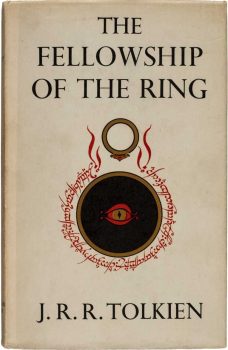 ing to remember when I first read The Lord of the Rings and it must’ve been when I was ten or so, meaning in 1976 or early 1977. I say this because my dad bought me The Silmarillion for Christmas and it was published in September 1977. That means I read The Hobbit when I was nine or so. Coming up on 59 next year, it means I’ve been reading Prof. Tolkien’s work for nearly fifty years.
ing to remember when I first read The Lord of the Rings and it must’ve been when I was ten or so, meaning in 1976 or early 1977. I say this because my dad bought me The Silmarillion for Christmas and it was published in September 1977. That means I read The Hobbit when I was nine or so. Coming up on 59 next year, it means I’ve been reading Prof. Tolkien’s work for nearly fifty years.
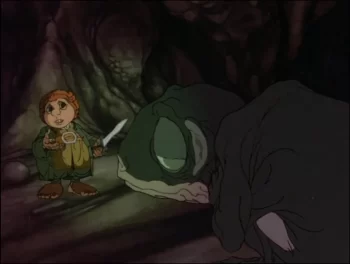 Rankin & Bass Bilbo and Gollum
Rankin & Bass Bilbo and Gollum
I assume I came across The Hobbit on my dad’s shelf next to his living room chair. It’s where he kept the various books he was reading at any given time. His habit was to stay downstairs till midnight or one, reading and listening to WQXR, the New York Times’ old classical station. I’d definitely read it before November 1977 when the Rankin & Bass The Hobbit premiered. As a side note, my dad tried to get our first color TV before it aired, but he wasn’t able to.
I didn’t read LotR right away, but when I did, I found myself in competition with my dad to finish them. With only the single set of books in the house, we read them in tandem. I remember rushing home from church to see if I could grab The Fellowship of the Ring before my dad had finished reading The New York Times that morning. Even though some days I got the book before him, he read faster and more often and finished several days before me. Hey, I was only ten.
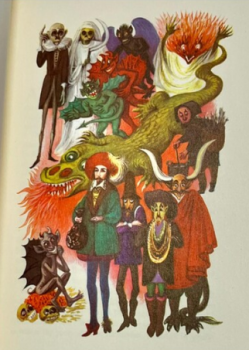 the Grimms’ devils & demons by Lucille Corcos
the Grimms’ devils & demons by Lucille Corcos
I grew up on fairy tales of all sorts, but particularly the unexpurgated Brothers Grimm stories. Lots of death, murder, cannibalism, witches, and demons were my standard fare. The editions we had were profusely and grotesquely illustrated. Those sorts of stories plus books like the D’aulaires Book of Norse Myths, meant by the time I read The Hobbit, I was ready and well-primed for it.
It remains a great read, and easily one of the most memorable fantasy stories I read early on. In Bilbo Baggins, Tolkien created the perfect stand-in for young readers. A bit naive, a bit scared of the dark, and, still, ready and waiting for adventure. Everything past the Shire’s boundaries was as new and enthralling for me as it was for him. The book is so vivid and so impressed on my mind from my very first read, if not word-for-word, I think I could do a pretty good job retelling the story from the very beginning. Fairy tales, I knew, were old stories, told and told again over the centuries. The Hobbit, even if it drew on that folklore tradition, was an original story and it whetted my appetite for more. It’s a straight line from that book to all my other fantasy reading over the following half-century. Before it pointed me to Moorcock, Wagner, and Howard, though, it pointed me to The Lord of the Rings. And in my case, that meant the editions with Barbara Remington’s phantasmagorical cover illustrations.
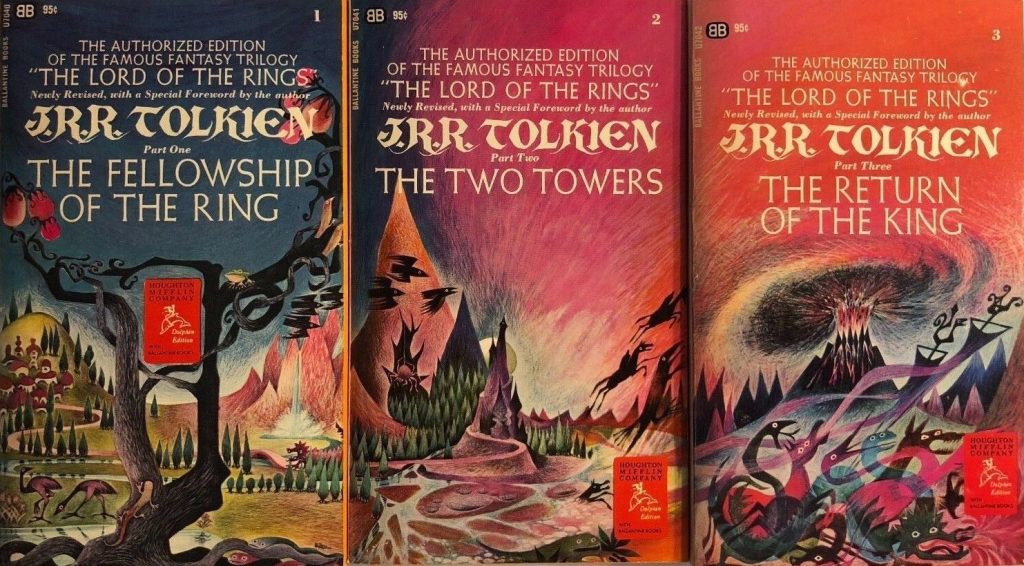 Covers by Barbara Remington
Covers by Barbara Remington
I spent some time puzzling over them trying to connect them to Tolkien’s prose. Sure, that’s Hobbiton to the left, Shelob’s lair and the Nazgul in the center, and Mount Doom and a battle on the right. They’re so stylized, though, that I wasn’t quite sure what to make of them. I mean, are those cassowaries on the cover of Fellowship? What’s that running through the woods? What is going on?
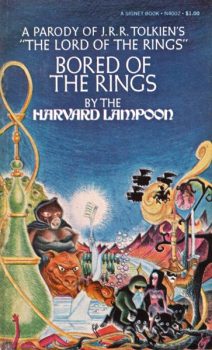 by Michael K. Firth
by Michael K. Firth
They, more than any of the covers since, are The Lord of the Rings covers for me, though. Those with Tolkien’s own paintings are fine, but the others are all too precise or realistic. Remington’s preserve the strangeness that the stories held me for me the first time I read them. My visions of Moria, Orthanc, and Minas Tirith were unburdened by decades of storytelling set in mock-medieval European settings. They rose off the page like the alien creations they were. The Hobbit and LotR were the first actual fantasy books I read. Fairy tales are set in fairy tale land, hazy and indistinct in their settings. Tolkien’s stories were the first I can recall that were set in lavishly described realistic landscapes with protagonists with some sort of characterization that went beyond stalwart prince or cunning soldier and mixed it with barrow wights, sword-wielding demons, and oathbreaking ghosts. That they’re also the basis for the original cover of the parodic Bored of the Rings only reinforces my love for them.
Tolkien and his books were just becoming commercialized when I first read them. The Brothers Hildebrandt produced several extremely well-selling calendars. Everyone and his brother wrote encyclopedias of Middle-earth or books explaining just what Tolkien meant. The extreme end of this trend was, I’d argue, the careful creation of The Sword of Shannara (read my review here), followed by stacks of books wherein doughty commoners trudged into some dark lord’s land accompanied by a small band comprised of elves, dwarves, and men.
Everyone I was friends with, by which I really mean everyone, read, or at least tried, to read Tolkien. We were all proto-fantasy nerds and it was great. The books were everywhere and I loved it. It felt like I was part of some special order that was privy to something extraordinary. Looking back, I think that was true.
When I told the luminous Mrs. V. how old I was when I read LotR, she asked me if I understood it. Without hesitation, I said yes. I did understand it, but mostly on a basic level, as an exciting tale of adventure filled with magic and monsters. What I missed at ten, came with later readings; an overwhelming sense of a fading world which darkness threatens to overwhelm and endlessly eroding the strength of those arrayed against it.
All the ruins and tombs that littered the land around the Shire are the broken remains of realms lost to the darkness. Vast swaths of Middle-earth are devoid of civilization and population having been devastated in past wars, barbarian invasions, and by plague. Some of the greatest powers that have stood against Sauron for thousands of years have decayed in the case of Gondor or succumbed to his temptations as has Saruman.
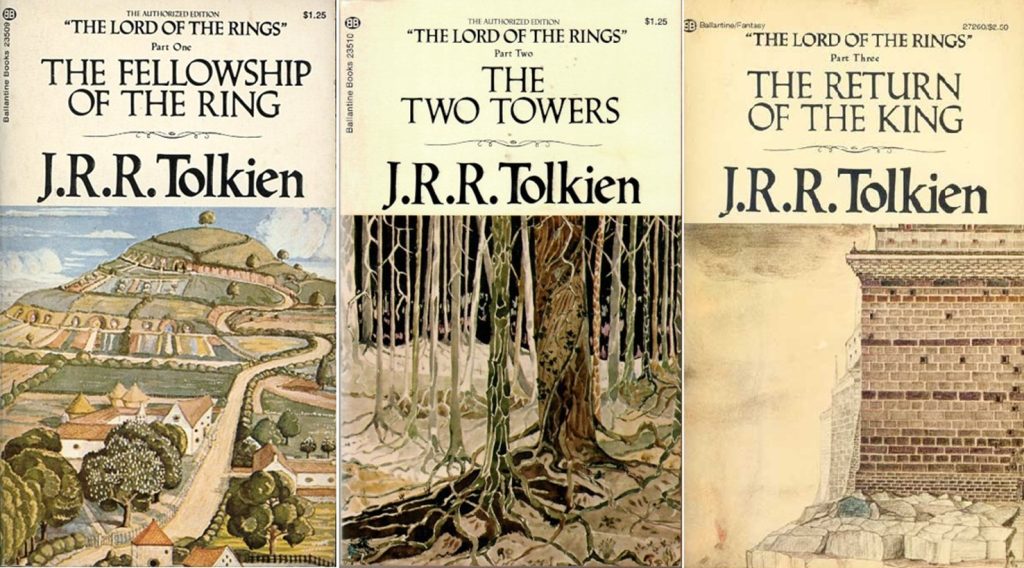 Covers by JRR Tolkien
Covers by JRR Tolkien
Reading The Silmarillion the first time around was mind-boggling. It was not the book I was expecting at all. It was a collection more like the collections of Norse and Greek myths I read than Tolkien’s previous novels. I wanted more LotR and instead, I got the Old Testament of the Elves. Notwithstanding, I got my first sense that Middle-earth was a broken world — quite literally in The Silmarillion. It was a place where evil constantly lurked and sometimes even marched out of its strongholds and crushed everything. It was a place where pride and arrogance constantly led to downfall and self-destruction. I got my first hint of what I had missed that first time around in LotR.
Tolkien described the book as “fundamentally religious and Catholic.” With further readings, while I might not have gotten that explicitly, I did see the moments of grace and Christ-like sacrifice that were essential elements of The Lord of the Rings. That they were manifested in a fallen world made them only more powerful. It became clearer with each reading that LotR was more than an epic adventure story. I’ll explore these in future articles about the individual volumes over the next few months. You see, I’m in the midst of another read of LotR, inspired by a rewatch of Peter Jackson’s movies.
I put Jackson’s Fellowship of the Ring on a few weeks ago for background noise and was immediately reminded of how much I’ve come to dislike it and its sequels. Again, I’ll go into more detail in later pieces, but suffice it to say, my distaste was enough to inspire me to pull out the real thing, open the cover and read those first lines:
When Mr. Bilbo Baggins of Bag End announced that he would shortly be celebrating his eleventy-first birthday with a party of special magnificence, there was much talk and excitement in Hobbiton.
In future installments I’ll write about the individual books of The Lord of the Rings; The Fellowship of the Ring, The Two Towers, and The Return of the King (if you’re very good, I’ll write about Bored of the Rings, as well). This will involve derogatory opinions of the Jackson movies as well as less harsh ones about Ralph Bakshi’s strangely appealing animated movie and even Rankin and Bass’ song-filled cartoon. I’m not sure how much anyone needs to read about Prof. Tolkien’s books at this point, but I really do feel the need to write about them. I hope you’ll follow along and tell me all your opinions about the books and movies, as well.
 The Bridge of Khazad-dûm by the Bros. Hildebrandt
The Bridge of Khazad-dûm by the Bros. Hildebrandt
Fletcher Vredenburgh writes a column the first Friday of the month at Black Gate, mostly about older books he hasn’t read before. He also posts at his own site, Stuff I Like when his muse hits him.
Prehistrionics, Part I
 Hatched (Uncorked, 2021)
Hatched (Uncorked, 2021)
We’re off on another adventure filled to the brim with disappointment. 20 films I’ve never seen before, all free to stream, all dinosaur-based.
Oh God.
Hatched (2021) PrimeJust how bad is the CG? Almost okay except when interacting with lunch.
Sexy scientist? Yep.
Mumbo jumbo? Cloning, reanimation, gene foolery.
There are a couple of production company names that, if they pop up at the beginning, let me know what to expect. Uncorked is one of them. Imagine my surprise then, when this film turned out to be competently shot and, for the most part, decently acted.
Filmed on one stately location in the UK, it’s basically a hide and seek story with CG dinosaurs. Despite the (you would imagine) adrenaline-laced plot, it’s all very pedestrian, nobody seems overly concerned, and I counted four, count ‘em, four very slow head turns in reaction to growling, just before snacking.
Dr Fannypack McSpaghettistraps trips over a twig in one of the more laughable moments, but on the whole I didn’t hate it. Probably because I know there is much worse to come.
5/10
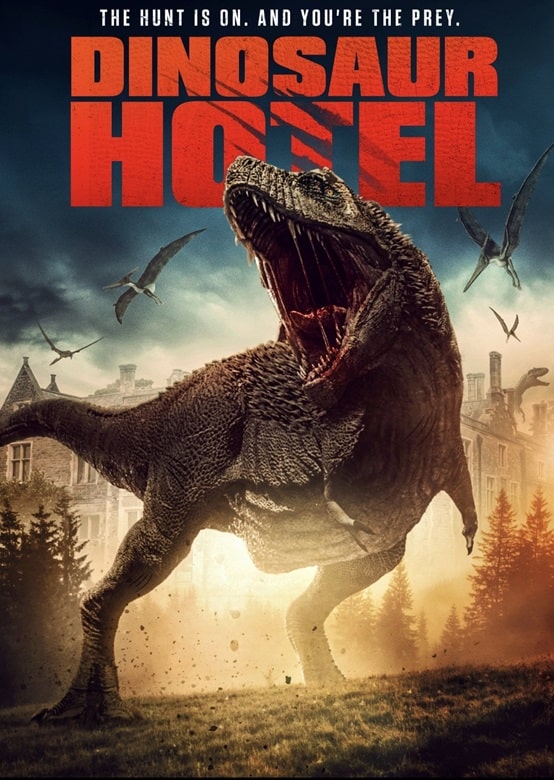
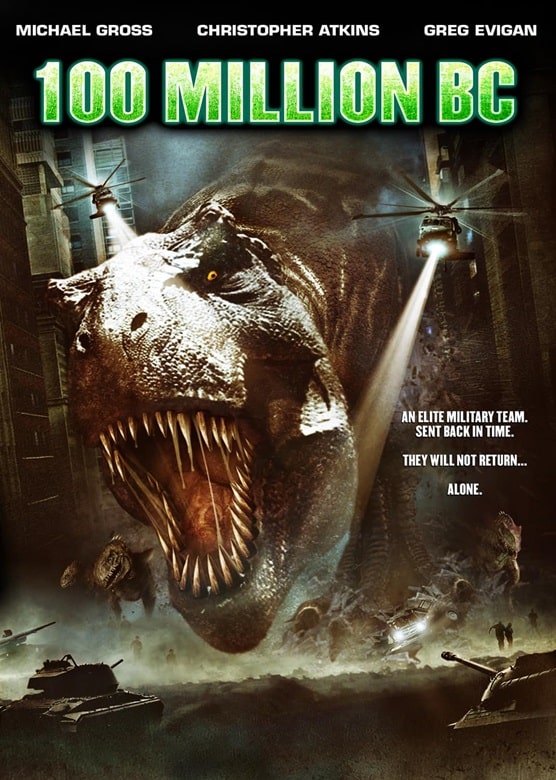
Dinosaur Hotel (Jagged Edge Productions, 2021), and 100 Million BC (The Asylum, 2008)
Just how bad is the CG? Pretty terrible.
Sexy scientist? Nope.
Mumbo jumbo? Unexplained dinosaurs, game show, floating robot.
Another UK production shot in a single stately location somewhere ‘oop North.’ This one is a simple idea; put a bunch of ladies in a big house and terrorize them with bad computer graphics.
It’s nonsense, but that’s what I came for — however, any possible enjoyment I might have teased out of this mess was marred by some pretty bad child acting. I realize this makes me a B-movie grinch for ragging on kids, but come on, there are decent child actors out there, and even if you can’t afford one, you can direct kids with a bit of care and attention. That said, it looked like the children were having a great time on set, so good for them.
The CG creatures were as bad as Hatched, and I might not be a compositor of any great skill, but even I know how to match lighting, film grain and focal length to make it look like your digital creations are actually in the scene. Still, it wasn’t shot with Uncle Larry’s 1998 camcorder, so a bit of it was good to look at.
4/10
100 Million BC (2008) YouTubeJust how bad is the CG? Pretty damn terrible.
Sexy scientist? Sexy nurse, sexy nurse assistant.
Mumbo jumbo? Wormholes, time travel.
The Asylum is great at getting knock-off movies out faster than the real thing, so just as Emmerich was about to unleash 10,000 BC, the Asylum churns out this dollop.
Potentially it could be fun, Navy Seals sent back in time on a search and rescue mission, but the effects are so laughably lousy, and the direction so wooden, that it’s a real slog. Not even Nurse Perky McShirtgape or her assistant, Crevasse McSlitskirt, can save it. Dire.
3/10

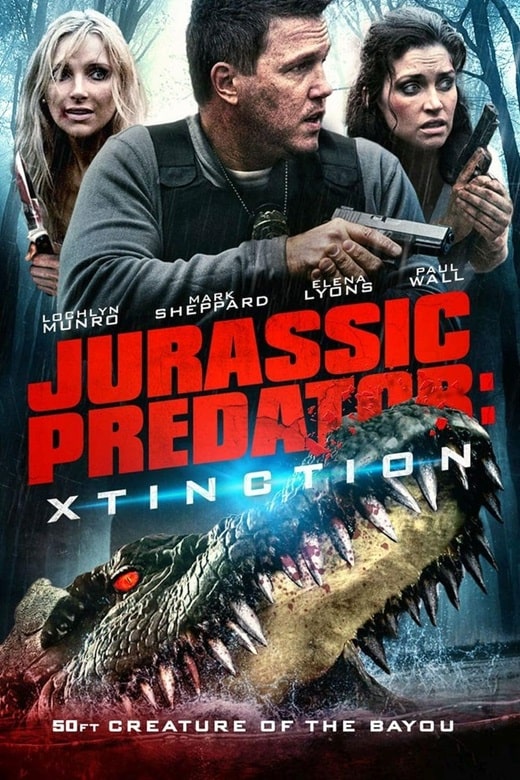
Raptor (New Concorde, 2001), and Jurassic Predator: Xtinction (K2 Pictures/Leverage Entertainment, 2010)
Just how bad is the CG? None! It’s all rubbish puppets and body suits.
Sexy scientist? Sexy Animal Control Officer.
Mumbo jumbo? Cloning, Project Blue Book.
A swift glance at the talent involved in this, and you might be forgiven for thinking you had struck gold. Scored by James Horner, produced by Roger Corman, starring Eric Roberts and Corbin Bernsen (who is clearly having the time of his life). Well, maybe not gold, but not a polished turd either.
It’s ludicrous, decidedly dodgy at times, and features an unfeasibly raunchy Animal Control Officer, ACO Tightpants McTightertop, who might be a little out of her depth. The dinosaurs are hysterical/cute/rubbish puppets, but there’s some fun, practical gore FX on show, and when it finished I was actually disappointed, however that could be down to tonight’s choice of intoxication.
5/10
Jurassic Predator: Xtinction (2010) YouTubeJust how bad is the CG? PS3 quality.
Sexy scientist? Sexy Scientist Spouse.
Mumbo jumbo? Cloning
A cloned mosasaurus is chowing down on hapless swamp denizens in this suitably hokey B-movie. Mark (Stargate) Shepherd plays the sleazy scientist with a couple of hillbilly goons in tow, and it’s up to his ex-wife (Elena Lyons, who looks like she’s not having fun) and the impossibly likeable Lochlyn Munro to make him ‘xtinct’.
The effects aren’t great, but they’re a step up from the usual rubbish, although the titular beastie could have done without the goofy eyes, and it takes itself far too seriously for this genre, but I didn’t hate it.
5/10
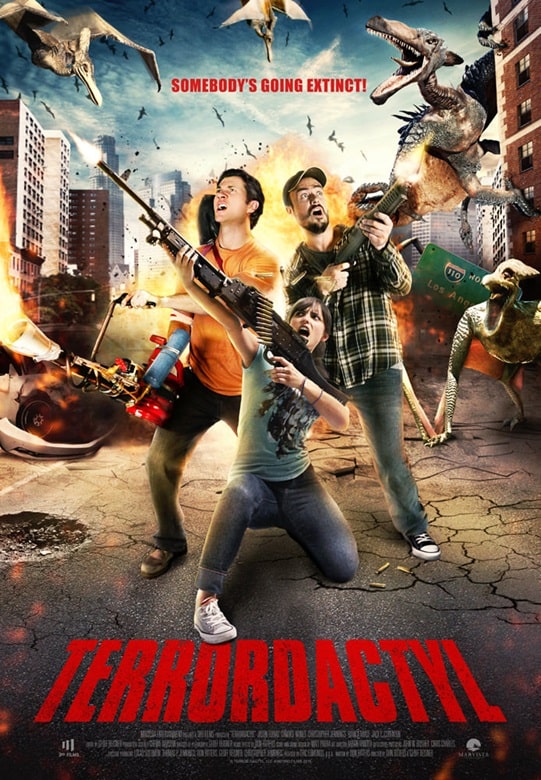
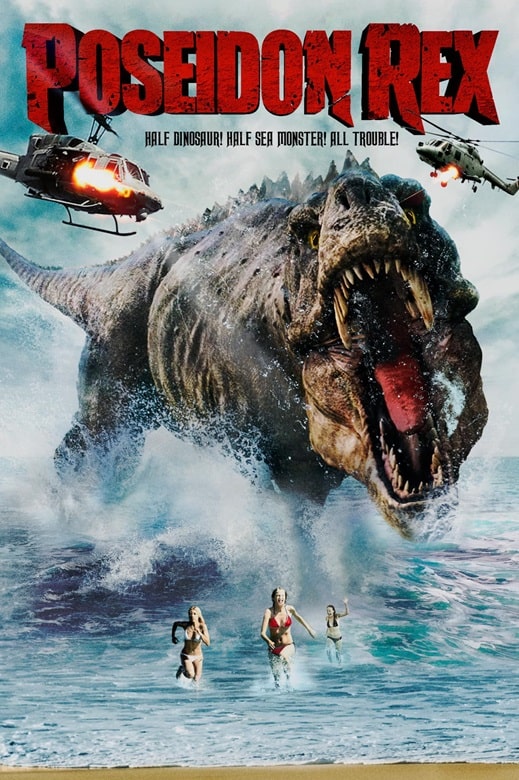
Terrordactyl (3rd Films, 2016), and Poseidon Rex (Titan Global Entertainment, 2013)
Just how bad is the CG? Actually, not terrible.
Sexy scientist? Nope.
Mumbo jumbo? Meteor eggs, space dinosaurs.
Well, it took six films, but we finally got a good one (and when I say good, remember the height of the bar). Terrordactyl knows exactly what it is supposed to be and goes for it, bringing the humor, cheesiness and monster action in spades.
The gore is PG13 level, but the creatures were fun and well animated — the FX team did a solid job on the budget they had. The two leads were likeable, with great banter and action set-pieces, but the star for me was Candice Nunes as the cute, kick-ass, bartender. She was really good and, seeing that she’s in the next one I’m watching, Poseidon Rex, I’ll be going in with less dread.
This film put me in mind of Big Ass Spider — it had the same tone, and managed it on a lower budget.
I’d say watch this one.
7/10
Poseidon Rex (2013) YouTubeJust how bad is the CG? Horrible.
Sexy scientist? Yep.
Mumbo jumbo? Mayan gold, aquatic sauropods.
After yesterday’s half-decent effort, I thought my luck had changed. Far from it. My one ray of hope, Candice Nunes, was wasted, and instead I sat through insufferable acting, lackluster direction and a script as clever as a parsnip.
The saddest thing about it all is that it was directed by Mark L. Lester, who was once able to entertain us with classics such as Commando and Firestarter — but here he just banged out some takes over a couple of weeks in sunny Belize, and then left it in the hands of an incapable editor. Co-produced by, and starring Brian Krause, who makes sure he hooks up with Dr. Pneumatica McSideboob, this is one to avoid.
3/10
Previous Murkey Movie surveys from Neil Baker include:
Jumping the Shark
Alien Overlords
Biggus Footus
I Like Big Bugs and I Cannot Lie
The Weird, Weird West
Warrior Women Watch-a-thon
Neil Baker’s last article for us was Jumping the Shark, Part III. Neil spends his days watching dodgy movies, most of them terrible, in the hope that you might be inspired to watch them too. He is often asked why he doesn’t watch ‘proper’ films, and he honestly doesn’t have a good answer. He is an author, illustrator, outdoor educator and owner of April Moon Books (AprilMoonBooks.com).
A to Z Reviews: “Wasted Potential,” by David Lee Zweifler
 Over the past several years, I’ve embarked on a series of year-long review cycles at Black Gate. In 2018, I reviewed a story-a-day to coincide with an author whose birthday it was. In 2022, I selected stories completely at random from my collection to review. In both of those cases, the projects served to find forgotten and minor works of science fiction that spanned a range of years. They also served to make me read stories and authors who I haven’t read before, even if they were in my collection.
Over the past several years, I’ve embarked on a series of year-long review cycles at Black Gate. In 2018, I reviewed a story-a-day to coincide with an author whose birthday it was. In 2022, I selected stories completely at random from my collection to review. In both of those cases, the projects served to find forgotten and minor works of science fiction that spanned a range of years. They also served to make me read stories and authors who I haven’t read before, even if they were in my collection.
For this year’s project, I’ve compiled a list of all the stories and novels in my collection. I then identified the first and last works for each letter of the alphabet and over the next twelve months, I’ll be looking at those works of fiction, starting with Vance Aandahl’s “Bad Luck” and ending with David Lee Zweifler’s “Wasted Potential.” Looking at the 52 works (two for each letter), I find that I’ve only reviewed one of the works previously. Interestingly, given the random nature of the works, only three novels made the list, while four anthologies have multiple stories on the list. The works range in publication date from 1911’s “The Hump,” by Fernan Caballero to Zweifler’s story from 2023.
After a year, we finally come to the end of the alphabet, with David Lee Zweifler’s “Wasted Potential,” which was published in the November/December 2023 issue of Analog.
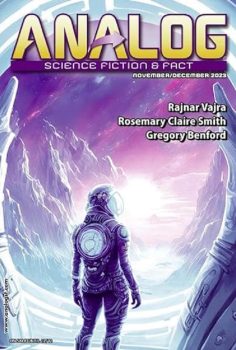 Cover by 123rf
Cover by 123rf
After being laid off from his job as head of product for a fruit-flavored diet carbonated beverage, Elliott has hit the job market, using the newest technological advances to find the perfect job for himself. Unfortunately, the promise of quantum computing, which should make the job search (and everything else in life) easier, is not functioning the way Elliott would like it to.
The training videos promise exciting jobs, such as space piracy, interstellar zoo seeping, and other off-world adventures. Elliott’s own job searches are offering payroll, management, and billing positions in such hotspots as Cleveland, Waco, and Cairo, the one in Indiana, not even the one in Egypt. The dichotomy of the promises and the reality only leave him dissatisfied and wanting more.
Even worse, it makes him feel as if he is holding his girlfriend, Daphne, back from achieving her own potential. The wasted potential of the title, therefore, is not only his own, but also what he is doing to the woman he loves.
Zweifler offers an interesting conceit, but what makes the story successful is that he doesn’t take any of it too seriously. Elliott’s accidental deactivation of the microphone on his speaker means that the only way he has to communicate it through his AI coffeemaker, which has a lower opinion of Elliott and his potential than Elliott does.
While the humor of the piece doesn’t always work, it is present throughout as Zweifler offers a satirical look at job searches, AI, and instruments that are meant to make our lives easier. Perhaps Zweifler is aiming at too many targets or perhaps the humor exhibited isn’t quite biting enough to offer a sting. Humor, of course, is subjective and at the very least, he offers the story with a lighthearted touch throughout.
His character’s job search includes nice homages to Robert A. Heinlein’s Starship Troopers and Frank Herbert’s Dune.
And that ends my series for 2024. I’ll be taking a short break from the pages of Black Gate, returning with the start of a new series of articles at the end of February.
 Steven H Silver is a twenty-time Hugo Award nominee and was the publisher of the Hugo-nominated fanzine Argentus as well as the editor and publisher of ISFiC Press for eight years. He has also edited books for DAW, NESFA Press, and ZNB. His most recent anthology is Alternate Peace and his novel After Hastings was published in 2020. Steven has chaired the first Midwest Construction, Windycon three times, and the SFWA Nebula Conference six times. He was programming chair for Chicon 2000 and Vice Chair of Chicon 7.
Steven H Silver is a twenty-time Hugo Award nominee and was the publisher of the Hugo-nominated fanzine Argentus as well as the editor and publisher of ISFiC Press for eight years. He has also edited books for DAW, NESFA Press, and ZNB. His most recent anthology is Alternate Peace and his novel After Hastings was published in 2020. Steven has chaired the first Midwest Construction, Windycon three times, and the SFWA Nebula Conference six times. He was programming chair for Chicon 2000 and Vice Chair of Chicon 7.
T.H. White’s Legacy on Contemporary Television
 Ted Lasso (Warner Bros. Television/Apple TV+, 2020-2023)
Ted Lasso (Warner Bros. Television/Apple TV+, 2020-2023)
I recently re-watched Ted Lasso, and as I took in the final episode, I was reminded quite forcibly of The Queen’s Gambit. The question was, why? I quickly cued up The Queen’s Gambit, and sure enough, my memory held true: both shows employ what I like to call — what I am going to call, starting here, with this essay –– the T.H. White Stratagem.
If I may explain. The T.H. White Stratagem (a clear misnomer, since to my knowledge he deployed it only once) stems from the climax of The Sword in the Stone, book one of The Once and Future King. If you haven’t read this wonderful masterwork, please skip the remainder of this essay, and come back later. For those that have read TOFK, recall that in London, at the great tournament, (Sir) Kay dispatches the Wart to run back and get his sword, which Kay has foolishly left back at the hostel.
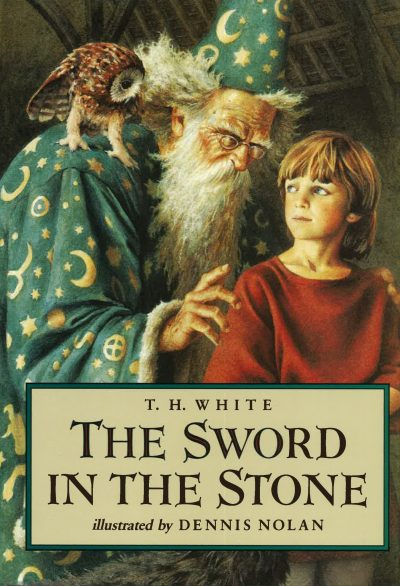 The Sword in the Stone by T.H. White (Viking Books Illustrated edition, September 15, 1993). Illustrated by Dennis Nolan.
The Sword in the Stone by T.H. White (Viking Books Illustrated edition, September 15, 1993). Illustrated by Dennis Nolan.
Off trots the Wart, but in an echo of the New Testament, he finds, so to speak, no room at the inn: the door is locked. Desperate for a sword, any sword, the Wart discovers one in a chapel, with various banners arrayed on the high walls above. The sword, of course, is the sword, the Sword in the Stone (it’s also driven through an anvil, which never gets talked about), but the Wart doesn’t realize its importance. He just knows he needs to procure a sword, so he does his best to pull the blade free.
He fails.
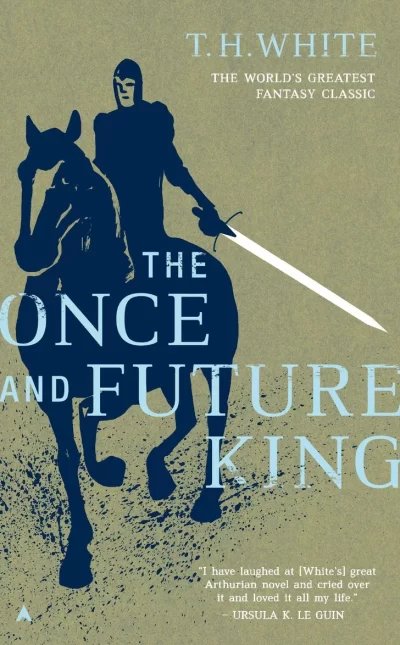 The Once and Future King by T.H. White (Ace Books, November 1, 2011)
The Once and Future King by T.H. White (Ace Books, November 1, 2011)
But then, the various creatures depicted on the banners ringing the room animate and begin proffering essential advice. Each is a representation of one of the many mentors the Wart met while growing up, each served up by Merlin with the goal of providing the Wart with the best possible education, that being the wisdom of the animal kingdom.
As the Wart keeps tugging, all his old friends summate their teachings, reminding the Wart of what he already knows: to use his back, and his brain, and to never give up. And with this chorus of boon companions cheering him on, from pike to badger and back again, the Wart at last succeeds; he yanks the sword free, and in so doing, becomes who he was always meant to be: Arthur Rex, ruler of Britain, the Once and Future King.
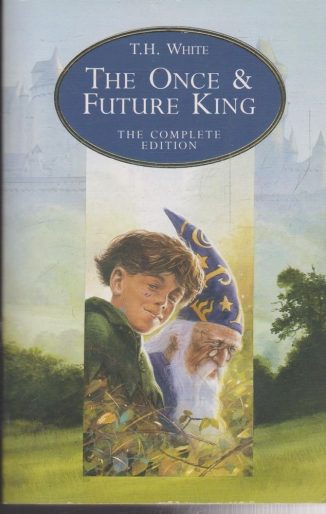 The Once and Future King by T.H. White (HarperCollins UK, December 1996). Cover by John Howe
The Once and Future King by T.H. White (HarperCollins UK, December 1996). Cover by John Howe
It’s an astonishing sequence. The first time I read it, I felt as if I’d been plugged into to an electric outlet; my hair all but stood on end. To have all those animals reappear, and so magically, so unexpectedly, and each of them standing ready to assist? Overwhelming. It was then and remains today an ecstatic piece of writing.
No surprise, then, that the formula of disparate friends who fall out of the narrative only to return to offer crucial support at a key moment has been absorbed by others, and put to good use.
In Ted Lasso, as Ted tries to close out his final match with a win, the show surrounds him with fans, from the pub faithful to the team’s former sports psychologist and all the way across the ocean to his ex, and his young son. The message is clear: Ted Lasso can’t win on his own. No one can. We get by with a little help from our friends.
 The Queen’s Gambit by Walter Tevis (Netflix, October 23, 2020)
The Queen’s Gambit by Walter Tevis (Netflix, October 23, 2020)
The Queen’s Gambit concludes with Beth Harmon at a chess tournament behind the Iron Curtain, in Moscow, but as with Coach Lasso and the unassuming Wart, she needs help from afar, and her friends (dare I say frenemies) rise to the challenge, coaching her through a rough patch over the telephone and, in one case, showing up in person (surprise!) to lend an ear.
A final example jumps to mind, from Star Trek: the Next Generation, and what many believe to be the show’s best episode, “The Inner Light.” Captain Picard winds up living an entire second life on a planet whose civilization has long since been doomed to extinction, and as his “story” there concludes, the deceased family and friends that he’s made along the way reappear for an emotional, benedictory send-off. As in TOFK, the hero can only succeed when surrounded by the support of steadfast mentors.
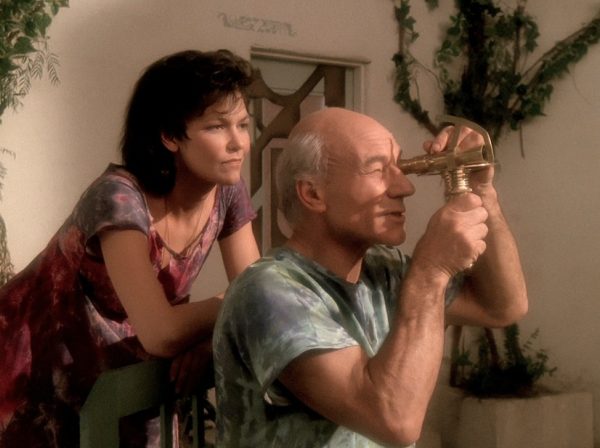 Star Trek: The Next Generation: “The Inner Light” by Morgan Gendel and Peter Allan Fields (Paramount Television, June 1, 1992)
Star Trek: The Next Generation: “The Inner Light” by Morgan Gendel and Peter Allan Fields (Paramount Television, June 1, 1992)
In thinking about the T.H. White Stratagem, it occurs to me that it functions as something like the inverse of the “assemble your team” plots exemplified by The Seven Samurai (or, if you prefer westerns, The Magnificent Seven). In these story-lines, the gathering-up of guides and fellow travelers dominates the proceedings, until by the end, the company splinters apart.
Unlike the White Stratagem, there is no culminating moment in which all that latent support coalesces around a single focal point, the all-important hero. Instead, the team works together toward a common rather than an individual end. But, both schemes certainly involve the mustering of allies, and are therefore inherently related.
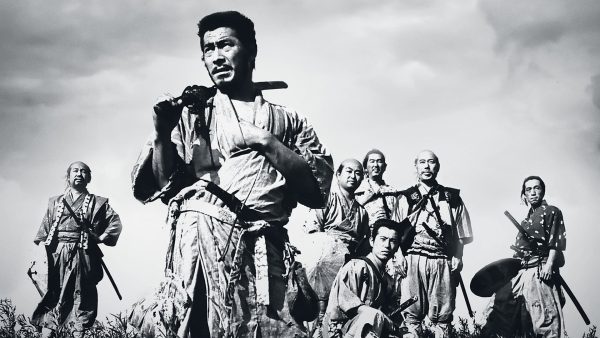 Seven Samurai (Toho, April 26, 1954)
Seven Samurai (Toho, April 26, 1954)
What I have not been able to bring to mind are other novels that either lean on or pre-date The Once and Future King, and also employ the T.H. White Stratagem. As a narrative device, it strikes me as so successful that it would be frankly incredible if it had not been used over and over –– and yet, nothing jumps to mind, not even The Book of Merlyn, since in that extraordinary coda to TOFK, the animal chorus is present throughout.
Perhaps you, Gentle Reader, can fill in some blanks and suggest examples?
Onward.
Mark Rigney is a writer and long-time Black Gate blogger. His work on this site includes original fiction and perennially popular posts like “Adventures in Spellcraft: Rope Trick.” His new novel, Vinyl Wonderland, dropped on June 25th, 2024. Reviewer Rich Horton said of Vinyl Wonderland, “I was brought to tears, tears I trusted. A lovely work.” His favorite review quote so far comes from Instagram: “Holy crap on a cracker, it’s so good.” A preview post can be found HERE, while his website lives over THERE.
The Sword & Planet Fiction of Robert Moore Williams: Zanthar
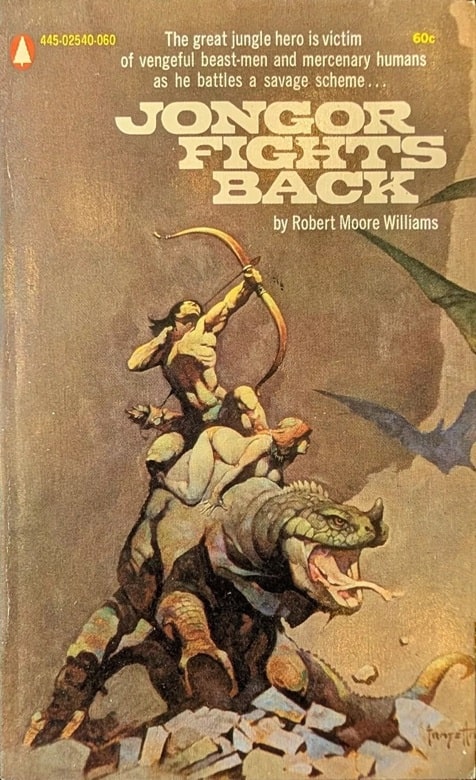
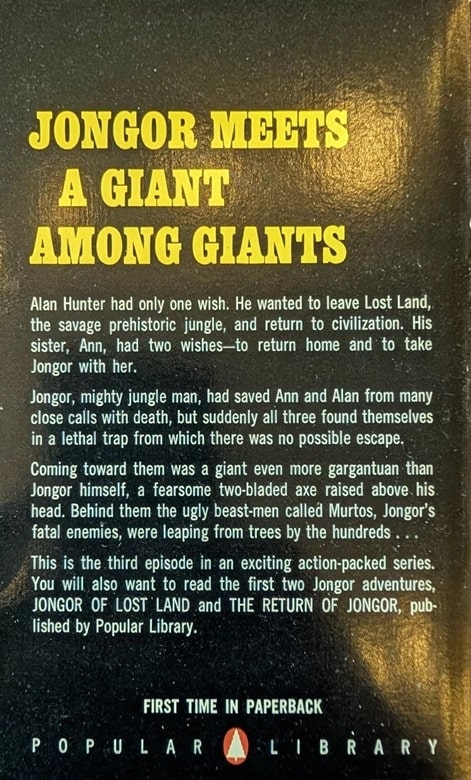
Jongar Fights Back (Popular Library, 1970). Cover by Frank Frazetta
Robert Moore Williams (1907 – 1977) wrote a lot of books, over 100. I’ve read two of them and that means there’s a 100 or so more books out there I won’t need to read before I die, including the ones he wrote under pseudonyms such as John Browning, H. H. Harmon, E. K. Jarvis, and Russell Storm. He also wrote an autobiography called Love is Forever – We Are for Tonight.
As a writer myself, I hesitate to be too critical of other writers. I know how difficult it is to finish a novel. But I don’t know how else to say it other than that — in my opinion — Moore was not a good one. The first book I found by him was Jongar Fights Back, a Tarzanesque effort featuring Jongar in a lost land. It was readable, but just barely. The cover, by Frank Frazetta, was a million times better.
[Click the images for Tarzan-sized versions.]
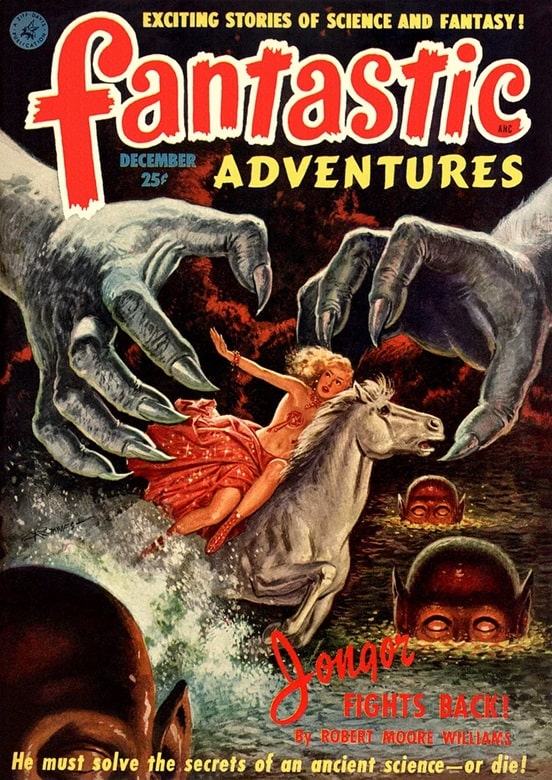 Fantastic Adventures, December 1951, containing the first publication of Jongor Fights Back. Cover by Robert Gibson Jones
Fantastic Adventures, December 1951, containing the first publication of Jongor Fights Back. Cover by Robert Gibson Jones
I found out this was the third book in the series, which included Jongar of the Lost World and The Return of Jongar. I decided not to spend any money getting them.
But then I saw Moore had written a Sword & Planet series. I had to have it and bought all four, shown below. All were from Lancer and as Lancers tend to do, they are falling apart.
The series in order is:
Zanthar of the Many Worlds 1967, Jeff Jones cover
Zanthar at Moon’s Madness, 1968, excellent Jeff Jones cover
Zanthar at the Edge of Never, 1968, Emshwiller cover
Zathar at Trip’s End, 1969, excellent Jeff Jones cover
I read the first one and put the other three away. Those of you who have been following this series know I love Sword & Planet fiction. It’s why I read a lot of it and why I write it. It can be the purest form of adventure fiction, and I take it seriously.
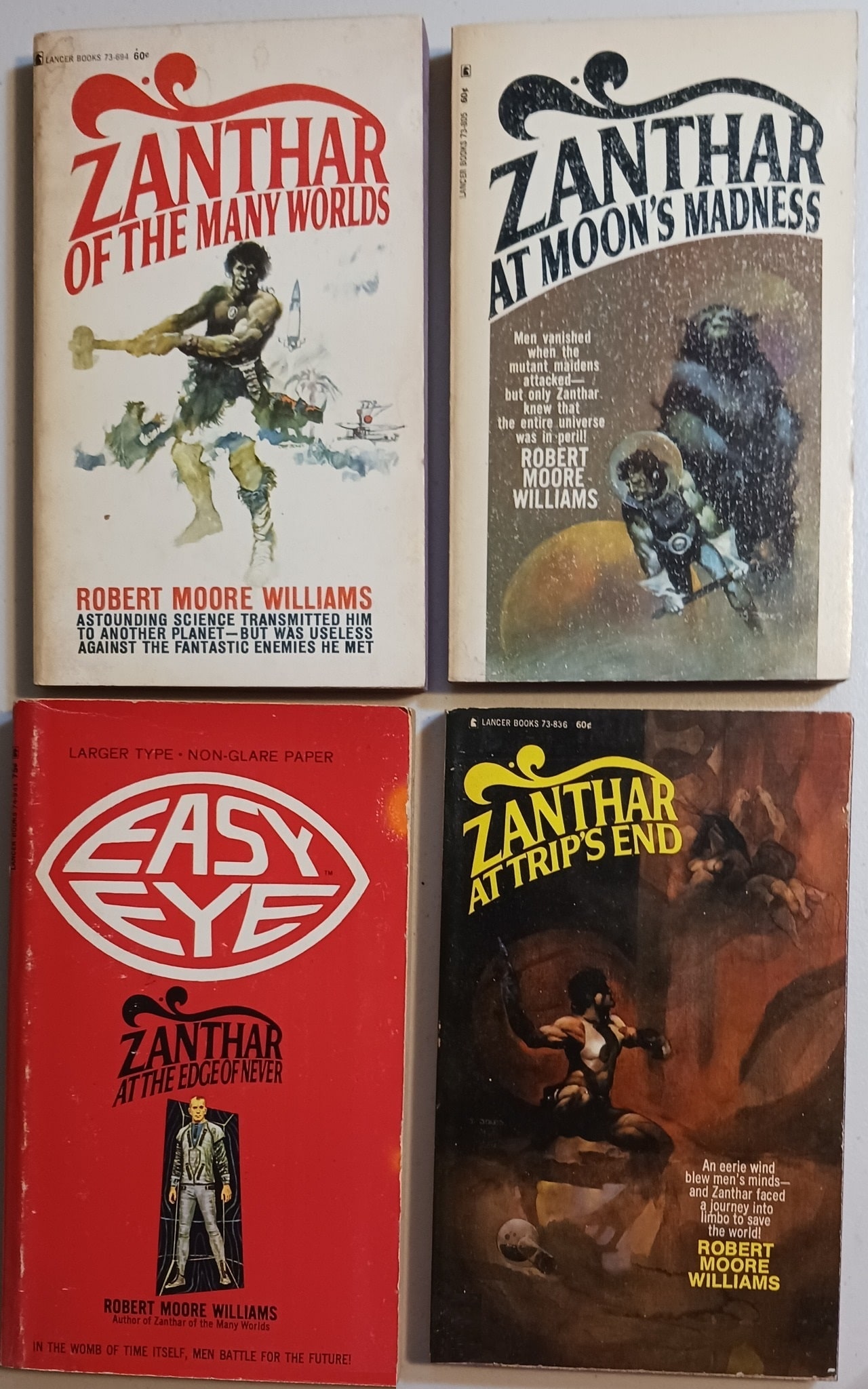 The Zanthar series (Lancer Books, 1967-1969). Covers by Jeff Jones and Ed Emshwiller
The Zanthar series (Lancer Books, 1967-1969). Covers by Jeff Jones and Ed Emshwiller
I also demand that the S&P writers I read take it seriously too. I’m afraid I can’t quite picture Robert Moore Williams taking the genre seriously.
I only read the first book, because it was just terrible. The book begins with John Zanthar, a brilliant Earth scientist who invents a machine that opens portals to other worlds.
Zanthar is sucked through it accidentally, and later two of his students are as well. So is a man named Fu Cong, who becomes the primary villain. So far, so OK.
Then the weaknesses arise. Most good S&P writers show that transportation to an alien world causes the hero some dislocation and discomfort. Not Zanthar. In the first few pages he acquires allies who decide he’s a god, and defeats the leader of a horde of attackers riding “miniature dinosaurs.” These appear to be T Rexes a bit bigger than the “Velociraptors” of Jurassic Park.
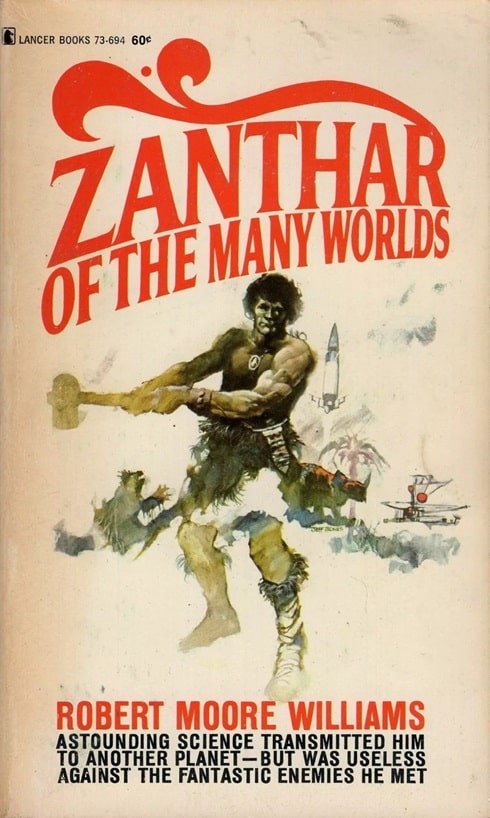
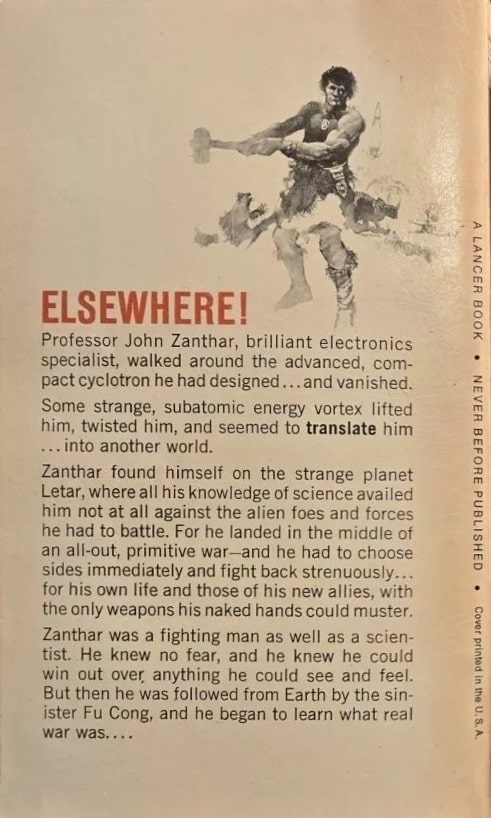
Zanthar of the Many Worlds (Lancer Books, 1967). Cover by Jeff Jones
Zanthar kills one dinosaur with a single blow from a “copper hammer” he’d been carrying in his lab when the transportation occurred. He also has no problem communicating with his new friends, who are conveniently riding telepathic beasts. And one of his new allies is a beautiful woman capable of healing any wound by laying hands on it and concentrating. Later she proves capable of raising the dead. (I’m not sure I’ve ever had a day that easy in the real world.)
I’m also a lover of good poetical prose, and the best S&P fiction has this. The prose in Zanthar of the Many Worlds is completely leaden, and in many cases just downright silly. Here’s a bit from early in the book:
And then: ‘The love-life?’ Zanthar questioned. He did not understand the term. In fact, he was not at all certain that he understood a tenth of the words she used. ‘I do not understand.’
The repetition was just wretched.
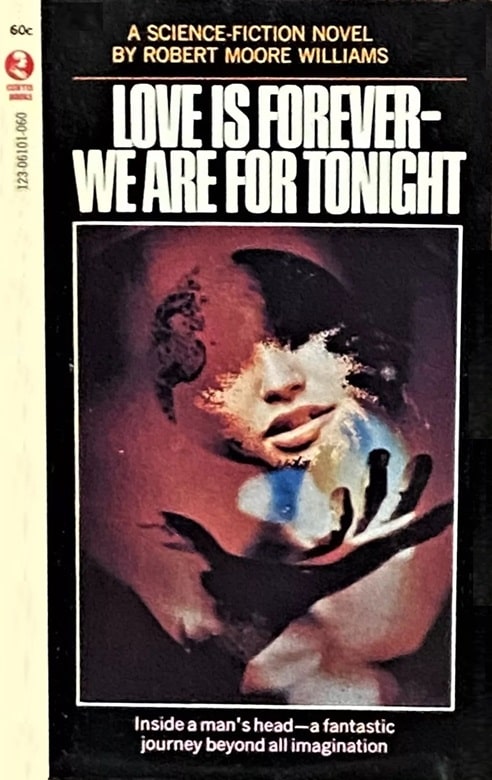
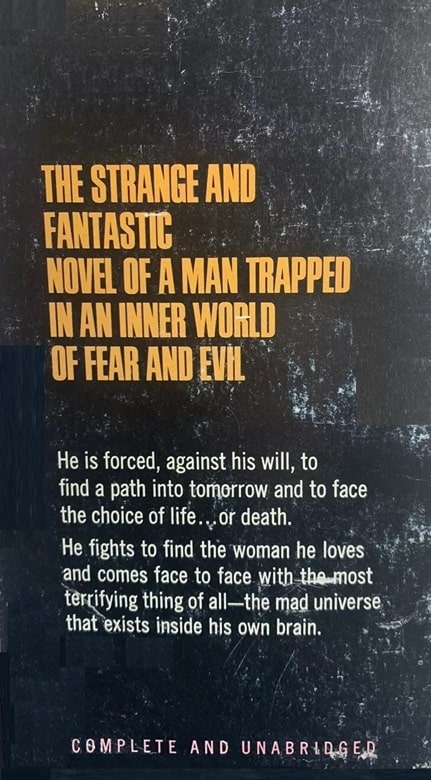
Love is Forever – We Are for Tonight (Curtis Books, 1970). Cover uncredited
Later, there’s an actual bit of dialogue imagined by Zanthar between atoms. I’m not making this up. Here it is:
Zanthar had the impression that he could hear the atoms talking each to the other, saying, ‘Brother, where are you?’
‘Comrade, what has happened?’
‘Sister, why are we in darkness?’
‘Cousin molecule, where has mother gone?’
‘And where is father?’
‘Is — is this the night that never ends?’ an atomic voice wailed.
‘Is — is this the end of the universe of atoms?’ another whispered.”
That was it for me. I scanned the rest of the book but can’t in good conscience recommend it to anyone.
I haven’t even tried the sequels. I can’t imagine they are better. I imagine these were published to take advantage of the paperback boom in the 1960s. The publication dates suggest they weren’t written exceedingly fast but Williams might have been writing a lot of other stuff at the time. They show very little evidence of careful construction. I read a quote once from Truman Capote about Jack Kerouac that I think applies to Robert Moore Williams: “That’s not writing, that’s typing.”
Charles Gramlich administers The Swords & Planet League group on Facebook, where this post first appeared. His last article for Black Gate was Chess in Sword & Planet Fiction, Part IV: Lin Carter’s Callisto.
The Failed Giant: Five Tributes to Barry N. Malzberg
 Barry N. Malzberg
Barry N. Malzberg
Barry N. Malzberg died on December 19. In his Black Gate obituary, Rich Horton wrote:
Malzberg was in his unique way a true giant in our field. Barry himself, in his later years, seemed to regard his career as a failure, but it was no such thing. He may have stopped publishing novels out of a feeling the publishing world wasn’t receptive to his work, but the best of what he did publish is outstanding, and thoroughly representative of his own vision.
Tributes and reminiscences have poured in over the last week, and many amplify Rich’s comments, especially in regard to both the importance of Malzberg’s work, and his embittered attitude towards the field near the end of his career. Several writers, including Adam-Troy Castro and Gregory Feeley, have generously granted permission for me to reprint their lengthy comments here, including several fascinating anecdotes.
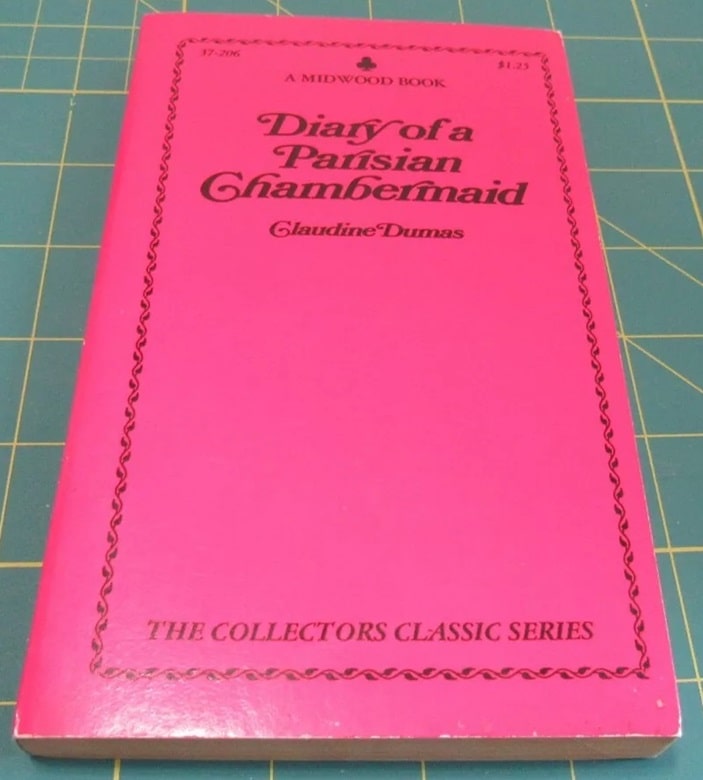 Diary of a Parisian Chambermaid by Claudine Dumas (Barry N. Malzberg). Midwood, 1969.
Diary of a Parisian Chambermaid by Claudine Dumas (Barry N. Malzberg). Midwood, 1969.
The quotes below have been edited for length.
Jeet Heer produced an insightful and entertaining retrospective of Malzberg’s lengthy career for The Nation, titled “Novelist on a Deadline: Barry Malzberg, 1939–2024.” Here’s an excerpt.
If your life absolutely depended on it, could you write a readable and publishable novel in 27 hours? In early February of 1969, that was the task an editor at Midwood books foisted on Barry Malzberg, then a 29-year-old rising star in the seedy world of the paperback quickie… On February 13, Malzberg sat down at the typewriter at 8 am and started banging away at his top rate of 60 words a minute… He finished the book the next day…
Malzberg, who died in a hospice in New Jersey on Thursday at the age of 85, flourished in the world of pulp fiction where quick writing was common: Malzberg’s friends Isaac Asimov and Robert Silverberg would both compile bibliographies of more than 500 titles. But even in that hurly-burly realm, Malzberg was a marvel. Reflecting on Diary of a Parisian Chambermaid in 2017, Malzberg told a podcast that, “in my opinion, with all deference to some writers we can name, it is the best novel written in 16 hours ever.”
In his peak decade, from 1967 to 1976, Malzberg wrote at least 68 novels and seven story collections along with scores of still uncollected stories published in many magazines and anthologies. He worked in a variety of genres, including mystery, thrillers, erotica, and adventure fiction, but his core work was in science fiction… Along with his peers J.G. Ballard, Samuel Delany and Philip K. Dick, Malzberg was a central figure in the movement of science fiction away from the external world of adventure fiction and outer space into the psychological torments and struggles of inner space…
But the struggle to write plays and stories for small literary magazines proved unappealing… In a 1979 interview, Malzberg recalled that in 1965, “I was being rejected. I was writing literary short stories and drowning in rejections and I just did not want to go any further. In October or November of that year I read in Galaxy magazine Norman Kagan’s story ‘Laugh Along with Franz.’ It was a brilliant, savage piece of science fiction, except it wasn’t science fiction at all, it was a serious, savage work of American fiction by a young American fiction writer. I shook my head as I read it and I cynically said to myself, if this son of a bitch can get away with this kind of stuff in the commercial science-fiction genre then I’ve got a future.”
By 1977, with the smash success of Star Wars, Malzberg’s somber and brooding fiction lost whatever cachet it once had. The dominant note of the genre returned to escapist adventure yarns. Malzberg, increasingly at odds with science fiction fans, wrote his last novel in 1983, although he continued to be a fecund writer of short stories.
The whole thing is worth reading. Check it out here.
John Clute shared a heartfelt reminiscence on Facebook on December 20.
Knew his work from the get-go. Finally met in the late 1980s. We were both (I guess) a bit clattery, but almost immediately found an affinity under the noise of being human, which never faded. Miss him hugely.
We both shared a sense of aftermath about science fiction; for me, from the outside, the end of sf started with the Five Point Palm Exploding Heart of Sputnik; for him it was more profound, intimate, painful. He was at the same time one of the funniest people I have ever met. Deadpan, irresistible. Passionate about the loss of the world. So I feel passionate now.
Robert J. Sawyer posted a brief tribute on Dec. 19.
The great Barry N. Malzberg has left us at the age of 85. Barry and I became friends during the many years we were both judges for the Cordwainer Smith Rediscovery Award, and when Barry retired from being the opinion columnist for Galaxy’s Edge magazine, I took his place.
Barry’s fiction was caustic and iconoclastic. His nonfiction about our genre was trenchant and heartbreaking; he knew what our field was capable of, and he decried the forces of publishing that so often kept if from fulfilling its potential.
Rest in peace, my friend.
I first heard about Malzberg’s death from Gregory Feeley, who shared the news on Facebook.
Thinking about Barry Malzberg, who died today. I was reading him in high school in 1970, when he appeared regularly in F&SF and Amazing. We corresponded for years, and talked at conventions.
I don’t think he ever read any of my fiction; by the 1980s he was largely disillusioned with science fiction, and focused his energies on the SF of his own youth. He did compliment me on my essays several times.
Barry was saturnine and frequently made predictions of an imminent disaster in the field, or perhaps in all of publishing. He was a cynic whose heart was always being broken, which I guess kind of makes him a failed cynic.
He could be awfully funny. I will miss him.
 Final War and Other Fantasies, by “K. M. O’Donnell” (Barry Malzberg), Ace Double paired with John Rackham’s Treasure of Tau Ceti (Ace Books, October 1969). Cover by Panos Koutrouboussis
Final War and Other Fantasies, by “K. M. O’Donnell” (Barry Malzberg), Ace Double paired with John Rackham’s Treasure of Tau Ceti (Ace Books, October 1969). Cover by Panos Koutrouboussis
Greg expanded on his thoughts in a revealing Dec 20 piece titled A BIT MORE ABOUT BARRY MALZBERG.
Barry Malzberg was born in 1938 and grew up reading 1950s science fiction. His favorite magazine was Galaxy, which (if you knew Barry and his taste) was totally unsurprising.
He ended up writing science fiction, but I don’t think he particularly meant to. He wrote the novelette “Final War” in the mid-sixties, and described how he could not sell it to any of the slick magazines — Playboy, Esquire, The Atlantic. Finally he sold it, under a pseudonym, “K.M. O’Donnell,” to F&SF.
Meanwhile he published some short fiction, first a story in Escapade (a third-tier men’s magazine) in early 1967, and then a short-short to Fred Pohl in Galaxy later that year. The Escapade story was published under his own name, but the Galaxy story was by K.M. O’Donnell. Barry immediately sent Pohl a sequel, which Pohl bounced, noting that sequels were usually bad ideas (which Barry admitted he knew). He went on to write a number of SF stories in 1967-68, and some appeared in F&SF and Galaxy. All were as by K.M. O’Donnell
“Final War” was a Nebula finalist in the spring of 1969, and on the strength of that, Barry put together the stories he had written, including those he had not found a publisher for, and sold them to Donald Wollheim as a 129-page Ace Double, Final War and Other Fantasies. He published a second Ace Double, Dwellers [of] the Deep (113 pages), the next year.
It was in 1970 that Barry began to publish SF under his own name. (I read the first two stories, in the Harry Harrison anthology NOVA 1 and in the April F&SF, when they came out.) A few stories as “by K.M. O’Donnell” came out over the next couple years. Perhaps they had already gone out, or been sold, under that byline.
In 1971 Barry published first SF novels under his own name. He published almost entirely under his own name from that point on.
One conclusion to draw from this is that Barry wanted, very badly, to be a mainstream literary writer, and when he was driven to send the stories he could not sell in the mainstream to SF magazines, and to write some expressly for the SF market, he used a pseudonym.
When he realized that he could not sell mainstream stories (or — after a few more Olympia titles — novels) and that he could sell SF, he decided that he was going to write SF, and a lot of it. But I believe that all his SF (except for “Final War” and maybe one or two other early ones) was written in the awareness of being a failed mainstream writer and that this deeply colored the stories he wrote: their mordancy, their obsession with failure, and — this was very clear in the non-fiction pieces he wrote, most of which were of a personal nature — an unmistakable degree of self-contempt.
 Dwellers of the Deep (Ace Books, December 1970). Cover by Jack Gaughan
Dwellers of the Deep (Ace Books, December 1970). Cover by Jack Gaughan
Gregory Feeley wrapped up his reminiscence with ONE MORE POST ON BARRY MALZBERG, also on December 20.
In the fall of 1973 Barry wrote a short piece, evidently for a fanzine that had asked for one, about the SF novel he had written in four days. The piece was apparently not published until his 1980 nonfiction collection came out, where he titled it “September 1973: What I Did Last Summer.”
He describes how he spent the summer writing three pseudonymous novels in the Lone Wolf series for Berkley, a movie novelization, and “Tactics of Mistake,” which he produced after Roger Elwood got a contract to edit twelve SF titles for Pyramid. Elwood offered Barry $4000 for one. Elwood didn’t require even an outline, but he needed the novel quickly.
Barry accepted but insisted—it was apparently part of his paperback writer’s code — on not writing a word until he had the on-signing money in hand. By the time he got it, he didn’t have much time (although it was more than a week). Nonetheless, he took a 2600-word story he had written for F&SF and in four days turned it into the 55,000 word novel. Describing the process, he wrote: “My oh my did I pad and overload! Sentences became pages, paragraphs became chapters.” He added flashbacks and what he called “tasteful” sex scenes, explaining that sex in science fiction needed to be tasteful. (This is at once ironic — he knew that it was no longer true — and a kind of self-scorn.)
In the end, Elwood accepts the novel (Tactics of Conquest appeared in early 1974) and asks for another. Accepting, Barry decides that “I think I will expand my story ‘A Galaxy Called Rome,’ which I also wrote last summer. I can fill in on that one, too, and this story is nine thousand words, not twenty-six hundred, which makes it easier to bloat.”
He concludes by writing, “I am going to end this composition because I am very tired and you only asked for fourteen hundred words on what I did last summer and here they are and I hope my fourteen-dollar check will be payable on receipt because I really need the money. I really do. I always will. I’ll make sure of it.”
So what do we make of this? The self-loathing is so pronounced as to be a kind of performance, in which he wants to be both taken seriously and not actually taken seriously. He is certainly right that the novels were bloated. (The second one was called Galaxies, which Pyramid published in 1975, ran only 128 pages, but its proper length had indeed been those original nine thousand words.) On some level he knows that he was debauching his talent, giving readers too-short but overlong novels, and was taking advantage of editors who had trusted him to do something good. On another level, he is clearly proud of himself.
One explanation can be seen in the fact that most of the books Barry published during this period were dedicated to his wife and daughters. He was providing for them. He wasn’t going to starve in a garret writing brilliant short stories and infrequent brilliant novels like Theodore Sturgeon. He was doing to support his family.
On another level, he was clearly saying, “So, literary world, you don’t want me? You think I should be a crappy science fiction writer. All right — I will give that to you in spades.”
Barry published five SF novels in 1974 plus a collection (in addition to an unknown number of pseudonymous series books) and four in 1975 plus another collection. After that the number of book editors willing to publish him dropped off, and he began to write thrillers in collaboration with Bill Pronzini. Toward the end of the decade Doubleday published a novel and two (!) collections, but they did not go to paperback, so that was that.
Had had he spent more time on his novels and published fewer of them, would Random House and the others continued to publish him? I doubt it. Barry’s novels were strikingly similar in tone, most of them had very skimpy story lines (themes but no real plots), and he wrote repeatedly about the same things: political assassinations, astronauts going insane, and horse racing. Sometimes it was hack writers or chess players who were going insane, but the narrative tactics were almost identical.
Michael Moorcock once noted that M. John Harrison had a “somewhat narrow range,” on which he composed carefully written variations. Barry had a narrow range, but he was unwilling to make a meager living composing carefully wrought novels and stories. The two writers were similar in one respect and diametrically opposite in another.
Barry also had real problems with plotting. Nothing actually happens in most of these novels. (He was also very weak with portraying women.) He had his voice, sardonic, bleak, and often very funny, though it never really varied from one book to another. That was what his fiction offered.
Beyond Apollo was better than the story “Notes for a Novel About the First Ship Ever to Venus” and it won a prize, which allowed him to sell and write a lot of books quickly. But constructing flimsy story lines about the same miserable, obsessive characters in static situations didn’t work.
Naturally, this did nothing to allay Barry’s misery.
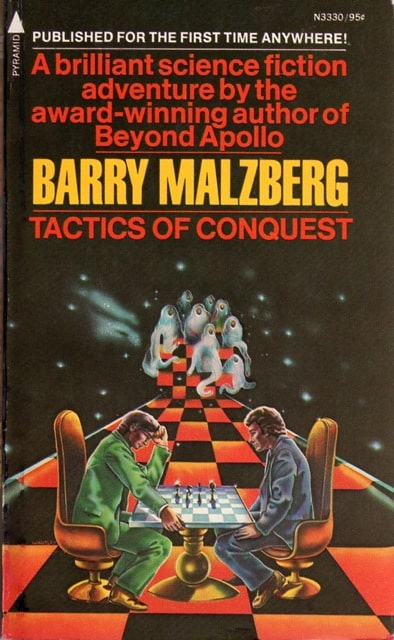
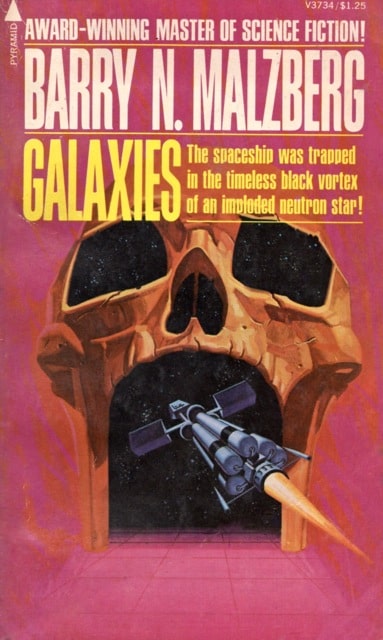
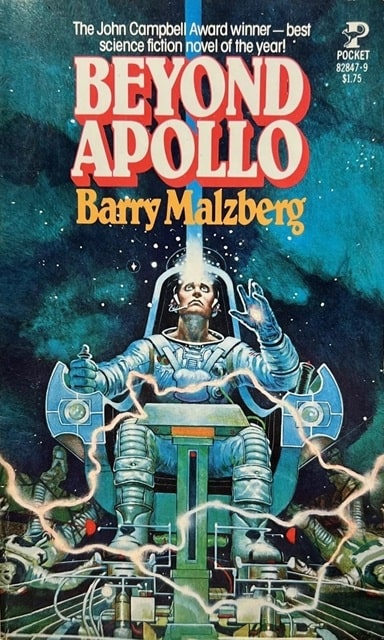
Tactics of Conquest (Pyramid Books, February 1974), Galaxies (Pyramid Books, August 1975),
and Beyond Apollo (Pocket Books, June 1979). Covers by Ron Walotsky, unknown, Don Maitz
I’d like to close this article with a pair of affectionate remembrances by Malzberg’s friend Adam-Troy Castro, the first shared on Facebook on the day he died.
Barry Malzberg has passed.
This is not a huge surprise. He was 85.
Nor is it a huge shock to the current system. Many, many years ago, I think before I had published anything, he was one of three powerful, dynamiting writers to declare publicly, and together, that they were done with science fiction. It was an attack on the infrastructure, not the potential of the field, and all three (Silverberg, Ellison and Malzberg) went back, though I think it was Barry whose public stance hurt him most — if not because he was less commercial, then certainly because he had leapt from a shorter precipice.
I think that from that point on, his output was one thin novel and a short story whenever it occurred to him, which was occasionally. Oh, and also a column for SFWA, which I will get to, cursing the necessity.
Barry was deeply aware that the publishing business included some scams that were aimed at writers of little promise, and for some time he worked, miserably, at the office of a major agent where it was his job to write encouraging letters which would encourage the wholly unpromising to send more, with additional agenting fees. This was shit work for him, and it did not thrill him.
Barry wrote dozens of novels, over a hundred I believe, some of which were absolutely terrific, but I think he won his place in posterity with two of them, in particular: Galaxies, which was self-described as not an sf novel but a series of authorial notes about a novel that could not be written; and Herovit’s World, about an sf writer who mass-produced novels about a Kirk-like character, but whose life never improved, until his sanity fractured and he became several personalities, including that of his protagonist. I think the novel a tour-de-force not specifically about science fiction, but about the writing profession, and it is nightmarish, and nightmarishly funny…
Where I am still irritated with the readership, and with much of the writership in general, was with the reaction a lot of people had to a column he wrote in collaboration with Mike Resnick, about (what we currently see as) old time editors, where the two long-in-the-tooth men talked about among other things the women in the field they had found attractive. This column erupted into a firestorm, something I fully understand, and still refer to as the time the two venerable and deeply respected figures stepped on their own dicks. I think they took as much anger as they deserved, as well as having the column taken away from them — but critically, also think they took more, in all the ways that we are now deeply familiar with, the self-righteous statements from unforgiving representatives of rage who wanted us to know that they had never even heard of Malzberg and Resnick, never had read anything they’d written, and “never would;” who then turned their rage on anyone, including myself, who agreed that the two old guys had overstepped but also held for the value of their respective bodies of work. How dare we?
I half-suspect that I might be the subject of rage just for saying this, but drawing a red marker over hundreds of works because you’re mad with the author, with full confidence that you’re missing nothing, is the act of a short-sighted idiot. (Now some of you will devote manifestos to why you’re entitled to, and please, the guy is being mourned here; don’t be an ass.)
And look, I know why people were mad at Malzberg. I even agree with them. I am, despite the assertions that will definitely accrue, fully able to admit that the two guys were acting in blind opposition to a world that had changed while they were not looking, and that the offense taken was entirely justified. But BEYOND THAT, he was in his time, one of the very best writers in the field, a prosesmith of incredible gifts, a guy who for years raged against the limitations of the literature and against the mostly-blinkered expectations of the fans, who he saw as enemies of the field’s possibilities. This was a brave position for him to take, and it cost him: I recall having a delightful lunch with him, just him and me and the actor Caryl Struycken (“Lurch”), who said nothing, at an I-Con where he was guest of honor, where he had to go to deliver his speech and later, heart-broken, reported that not a single person had showed up. I damned myself for not going. But goddamn it, he was the guy who wrote Beyond Apollo, The Time of the Burning, and the aforementioned Herovit’s World and Galaxies, and these were his monument, and what he deserved as legacy was not to have those few offensive paragraphs in the SFWA Bulletin forever pointed to as the reason he needed to be expunged and forgotten forever, but for a statute of limitations to pass so that his importance as a writer, and not as a sometimes blinkered gadfly, could pass back into relevancy…
He was a great writer, sometimes a very funny one, sometimes a heart-breaking one. He wrote at least one great novelette about the Kennedy assassination, that I cannot name now; but it is important to note that at least five of his shorter works are dancing in my brain now. He was important, I think. I deeply recommend that everybody who reads this obtain for themselves the collection, The Passage of the Light: The Recursive Science Fiction of Barry N. Malzberg, which contains a couple of novels and a scattering of short stories. “Herovit’s World” is among the contents. $14.00, still in print, worth getting…
Barry Malzberg, I salute thee. I am proud to have known you.
In a comment on a December 20 post, Adam-Troy shared a fascinating anecdote from one of Malzberg’s many convention appearances.
Barry really did think that the market for science fiction made it impossible to use it to tell adult stories. I remember thinking, “Well, if you want to be Joseph Heller, go ahead; you are that good.” And some of his novels were that good, including the two I keep singling out for special praise, Galaxies and Herovit’s World, both of which got lost in bookshelves with paperbacks that had rocket ships on the covers.
Nevertheless, when at science fiction conventions he quietly seethed that more of a fuss wasn’t made, and I clearly remember a ceremony where he came up to the big name who was sitting next to me and muttered, “I have to go, I can’t take any more of this.” Then he stormed off, and the big name, who I can no longer identify, said, “Barry doesn’t like getting a sub-ordinary audience for extraordinary stories.” And by then, based only on the evidence I had encountered in print, I would have done anything for him.
But also, I have to say, he was a great early model on the uselessness of wearing one’s professional heartbreak on one’s sleeve.
For a comprehensive summary of Malzberg’s accomplishments over a lengthy career, see his detailed obituary at Locus Online.
The Best of Bob: 2024
 Happy 2025! Let’s kick butt for another year. Or at least, limp to the finish 52 weeks. from now. I take what I can get. I started a Best of Bob feature last year. And while it may seem I’m constantly finding folks to write my column for me (hey – it’s a gift!), some of you Black Gaters may be surprised that I occasionally actually write my own essays for the Monday morning slot. John O’Neill is too savvy an editor for me to completely fool him for over decade.
Happy 2025! Let’s kick butt for another year. Or at least, limp to the finish 52 weeks. from now. I take what I can get. I started a Best of Bob feature last year. And while it may seem I’m constantly finding folks to write my column for me (hey – it’s a gift!), some of you Black Gaters may be surprised that I occasionally actually write my own essays for the Monday morning slot. John O’Neill is too savvy an editor for me to completely fool him for over decade.
So here are what I thought were ten of my better efforts in 2024. Hopefully you saw them back when I first posted them. But if not, maybe you’ll check out a few now. Ranking them seemed a bit egotistical, so they’re in chronological order. Let’s go!
1) Roaming the Old West, with Holmes on the Range (February 5, 2024)
It might look like I just throw something together every week (and looks aren’t always deceptive). But when I can find the time, I love putting together something special. And after reading/re-reading the entire series, I really nailed a three-part series on Steve Hockensmith’s Sherlock Holmes influenced, Old West mysteries about cowboy brothers Old Red and Big Red.
I followed up a pretty solid series overview, with the first-ever comprehensive chronology! And then, we rounded it out with a great Q&A from Steve himself. This is a terrific series: a great read, and solid on audiobook. Late in the year, the first two novels in a spin-off series that’s more Old West adventure than Holmes-flavored, came out. I’m looking forward to more of all aspects of the Double-A Western Detective Agency.
2) Terry Pratchett: A Modern-Day Fantasy Voltaire (March 25, 2024)For my birthday, I dug into the satirical aspect of the late, great, Terry Pratchett. I’ve written about Pratchett several times here. I treated myself to one of my periodic re-reads, and wanted to do a post. And I was rather pleased with this effort. Includes links to all the Pratchett essays at Black Gate, written by myself and others.
In May, I did another Pratchett post, as I had read/listened to almost two dozen novels. I do love me some Pratchett.
3) Doyle on Holmes (April 1 through May 13, 2024)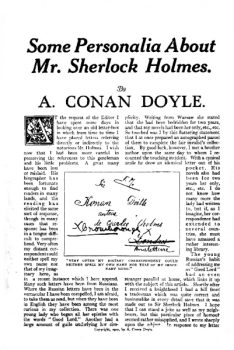 My second series of the year dropped on April 1. My first three years at Black Gate featured me writing The Public Life of Sherlock Holmes column. I’m ostensibly the in-house mystery guy, but I blog like a squirrel with ADD. I dug into my extensive Holmes library and found five essays which Arthur Conan Doyle wrote, related to his famous sleuth. I talked about each, mixing in extensive quotes from ACD, with my own thoughts. Plus a wrap-up on a key book I used.
My second series of the year dropped on April 1. My first three years at Black Gate featured me writing The Public Life of Sherlock Holmes column. I’m ostensibly the in-house mystery guy, but I blog like a squirrel with ADD. I dug into my extensive Holmes library and found five essays which Arthur Conan Doyle wrote, related to his famous sleuth. I talked about each, mixing in extensive quotes from ACD, with my own thoughts. Plus a wrap-up on a key book I used.
This was a pretty darn neat Doyle-centric look at Sherlock Holmes. Any Holmes fan should check this out.
4) Glen Cook: The Garrett, PI Q&A (April 8, 2024)I scored an interview with the social media reclusive fantasy icon. Cook’s The Black Company is a foundational series in whatever you call Dark Fantasy/Grimdark. And while I love that one, I’m a HUGE fan of his fantasy private eye, Garrett.
Glen graciously replied to a plethora of questions on the Garrett series. And we dipped into The Black Company, and I had a scoop!! It was known he was working on more Black Company, under the title A Pitiless Rain. From what I could find out, it was to be one or two novels. But Glen revealed in a follow-up email, he had three completed novels, and a fourth was half-finished! There’s also a completed Garrett novel as well.
Tor just revealed last month that Lies Weeping will be out in November of 2025. In December, I had a post which broke that They Cry will follow in November of 2026 (I had the wrong month, though). It was a big year for Glen Cook news, and I broke it. Not bad for a mystery guy.
5) Nero Wolfe’s Brownstone: Welcome to Kanawha Spa – The 2024 Wolfe Pack Greenbrier Weekend (May 27, 2024)More than Solar Pons and Sherlock Holmes and Leaphorn and Chee and The Continental Op, and….I’m into Nero Wolfe and Archie Goodwin. I constantly re-read the Corpus, and I’ve written uncounted words of fiction and non-fiction about them. I went to the gathering of Wolfe fans at West Virginia’s Greenbrier resort. The Greenbrier was the basis for Kanawha Spa in Too Many Cooks. It was a really fun weekend, and I wrote it up, with a TON of pics. The following week’s post was the Toast to Nero Wolfe, which I gave at the first dinner.
6) A (Black) Gat in the Hand: Harboiled Manila – Jo Gar (July 8, 2024)2024 saw the seventh year of my Pulp series, A (Black) Gat in the Hand. With some help from some talented friends, it’s now over 125 posts of Pulpy goodness. I’m really proud of this series.
I have long wanted to do an essay on Raoul Whitfield’s, Manila detective, Jo Gar. The little Filipino is a hardboiled Hercule Poirot, and it’s one of my all-time favorite hardboiled PI series’. I finally managed to finish one this year. You should absolutely check out Gar.
7) A (Black) Gat in the Hand: REH’s Swords of Shahrazar (September 2, 2024)I remain a huge Robert E. Howard fan. I even won my third Robert E. Howard Foundation award this year (a group project, with me one of four editors). El Borak rivals Conan as my favorite REH character. But Dave Hardy has written two elite essays on ‘The Swift.’
So, I did my second essay on another of his cowboys in the East, Kirby O’Donnell. I like him, and plan on covering the one remaining story. REH’s Oriental Adventures (the term does not mean Chinese or Japanese, as we think of it now) are really fun yarns. Click on over.
8) Ten Things I Think I Think: Marvel Edition (September 9, 2024)This remains my favorite recurring column. I mean, I give my opinions and thoughts on ten random things. What could be more fun for me? Over the Labor Day holiday, I watched almost two dozen Marvel movies. It was a lot of fun. I continued on and followed up the next week with a Five More Things I Think I Think.
If you’re a fan of the Marvel movie-verse, I think you’ll find at least a couple of things of interest. Check it out.
9) Gary Gygax’ 17 Steps to Role Playing Mastery (November 25th to December 9th, 2024)I don’t brag about my writing much, but I did a heck of a job with some strong multi-post series’ in 2024. I took Gygax’ Role Playing Mastery book and wrote a series on his 17 Steps to become a master Role Player. I included extensive quotes from him, along with my thoughts. This was based on a thread I ran on the Paizo boards, which ran to over 750 comments.
If you are at all into old school RPGing, I guarantee you will be interested in this one. It did not generate the comment volume I expected. But I have a couple more posts lined up
10) A Holmes Christmas Carol (December 23, 2024)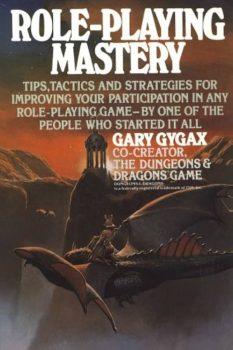 I have a half-dozen published Sherlock Holmes stories; and I’ve extensively written about him (see #3 above). I rewrote Charles Dickens’ classic novel (it’s not based on the movies, but the actual book) as a Holmes tale. I think I revealed some untold depth to Holmes, but I also stayed true to Doyle’s creation. Give it a holiday read.
I have a half-dozen published Sherlock Holmes stories; and I’ve extensively written about him (see #3 above). I rewrote Charles Dickens’ classic novel (it’s not based on the movies, but the actual book) as a Holmes tale. I think I revealed some untold depth to Holmes, but I also stayed true to Doyle’s creation. Give it a holiday read.
AND…..
I have some irregular columns which I write. Here are the most recent iterations, with links to the prior posts over the years:
(October 28, 2024)
What I’ve Been Reading: November 2024 (November 11, 2024)
What I’ve Been Listening (audiobooks) To: November 2024 (November 18, 2024)
Ten Things I Think I Think: December 2024 (December 16, 2024)
I try to write positive stuff, and I inject as much humor (often self-deprecating) as I can. Since they haven’t gotten rid of me yet (actually, I just keep figuring out how to get around the firewall), I must be doing something right.
If you’ve been reading my stuff, you know I reply to almost every comment. I love discussing the stuff I write about. It’s a big reason I pick the topics I do. And even if we disagree, we can have a cool discussion. So please, leave a comment on my posts, if you’re so inclined. Both of us might even learn something new!
Hopefully you’ll find more interesting stuff to read on Monday mornings in 2025. I’ll do my best to keep beating the security and post weekly.

Bob Byrne’s ‘A (Black) Gat in the Hand’ made its Black Gate debut in 2018 and has returned every summer since.
His ‘The Public Life of Sherlock Holmes’ column ran every Monday morning at Black Gate from March, 2014 through March, 2017. And he irregularly posts on Rex Stout’s gargantuan detective in ‘Nero Wolfe’s Brownstone.’ He is a member of the Praed Street Irregulars, founded www.SolarPons.com (the only website dedicated to the ‘Sherlock Holmes of Praed Street’).
He organized Black Gate’s award-nominated ‘Discovering Robert E. Howard’ series, as well as the award-winning ‘Hither Came Conan’ series. Which is now part of THE Definitive guide to Conan. He also organized 2023’s ‘Talking Tolkien.’
He has contributed stories to The MX Book of New Sherlock Holmes Stories — Parts III, IV, V, VI, XXI, and XXXIII.
He has written introductions for Steeger Books, and appeared in several magazines, including Black Mask, Sherlock Holmes Mystery Magazine, The Strand Magazine, and Sherlock Magazine.
From Al-Qadim to The East Mark Gazetteer
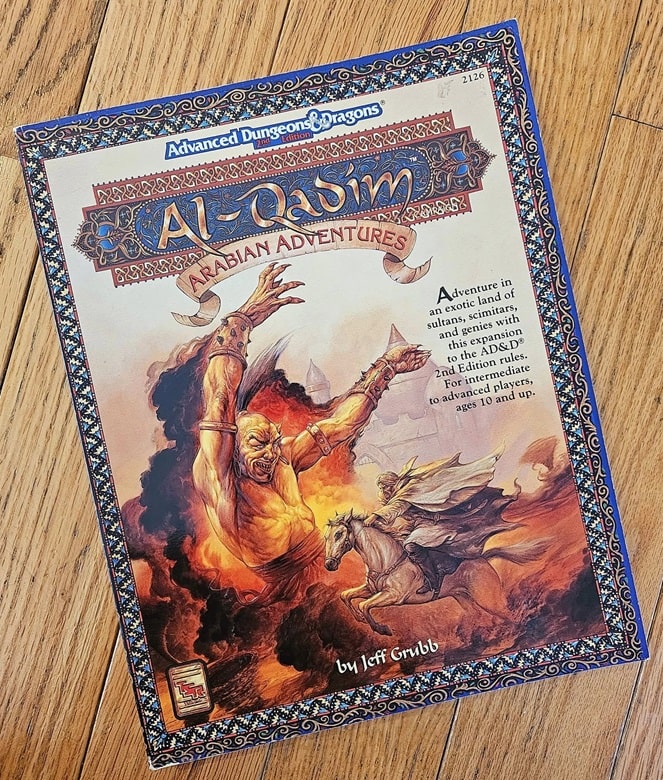 Al-Qadim: Arabian Adventures (TSR, 1992). Cover by Jeff Easley
Al-Qadim: Arabian Adventures (TSR, 1992). Cover by Jeff Easley
Al-Qadim: Arabian Adventures, by Jeff Grubb (with Andria Hayday), was one of the finest settings produced by TSR during the AD&D 2E (Second Edition) days.
“Magic carpets, ghoulish vixens, genies rising from the sand in a whirlwind of smoke and fire — such wonders, spin into tales by the fabled Scheherazade, enchanted a king for a thousand and one nights.”
The setting is inspired by Sinbad, Ali Baba, and other classics from Arabian Nights.

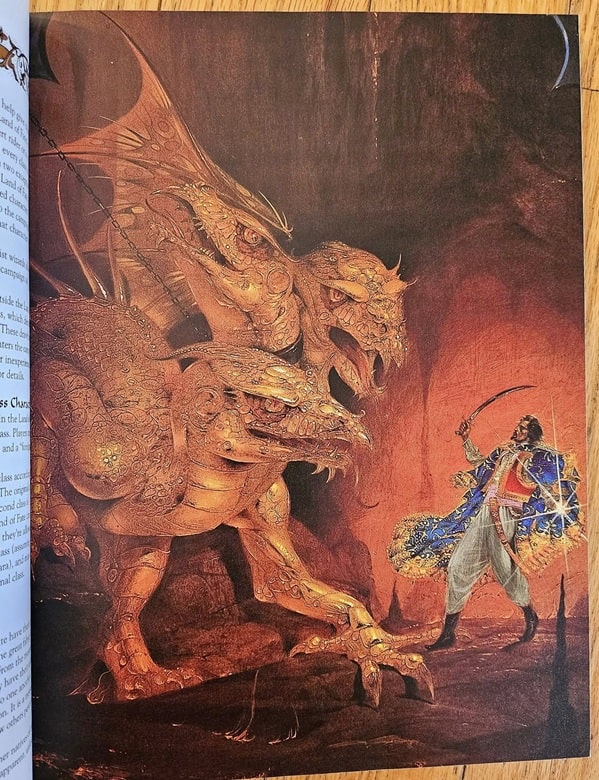
Maps and interior art for Al-Qadim: Arabian Adventures
As a huge fan of Sinbad – and especially the Ray Harryhausen stop-motion special effects – this setting really grabbed my attention as a young 21 year-old. It had rich flavor and culture, though was very D&D at the same time, with desert survival rules, special character classes, new spells, and (for me) the best part: a fully realized setting.
I think it’s excellent. And the embossed Jeff Easley cover painting is top-notch.


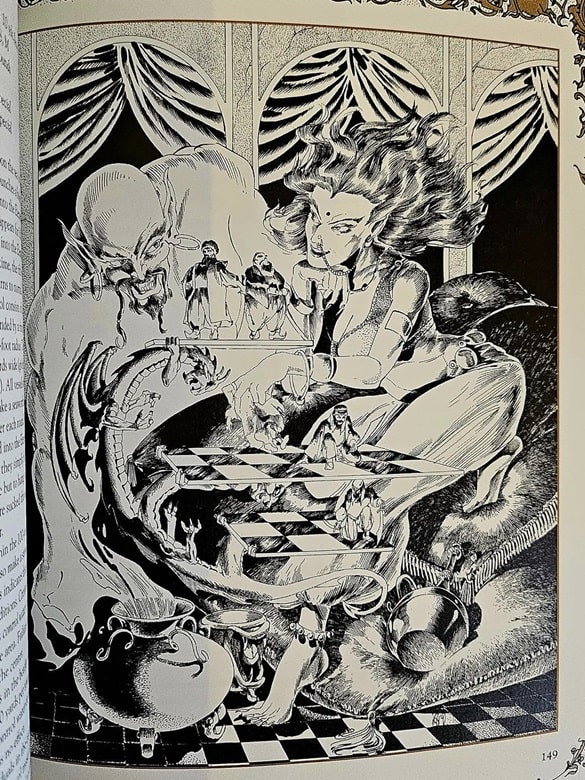
More interiors from Al-Qadim: Arabian Adventures
Do you have a favorite setting from the 2E era?
Back when I was a teenager in the 80s, running epic AD&D games in my basement for the other kids in the neighborhood, I never would have believed you if you’d told me that one day I would be working on Greyhawk materials with Gary Gygax, but to my great delight, it happened, and I will always remember those days (2005 – 2008) learning from and collaborating with a true legend.
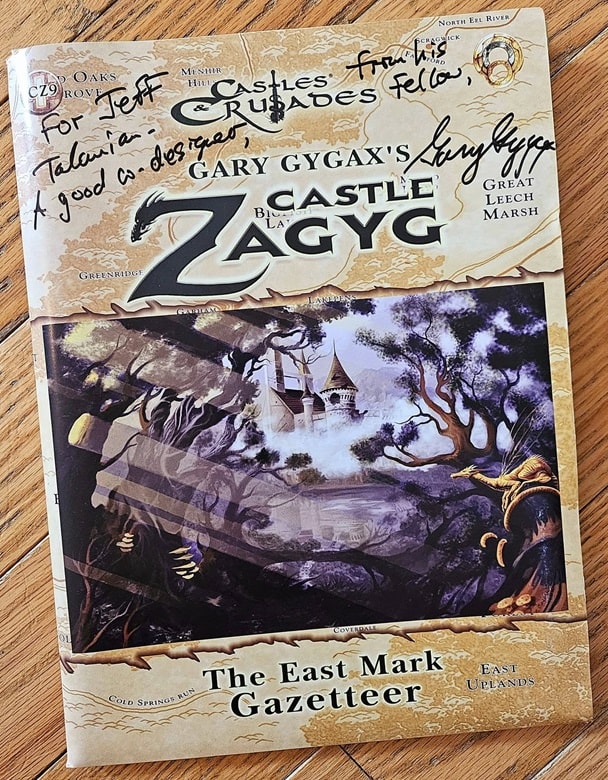
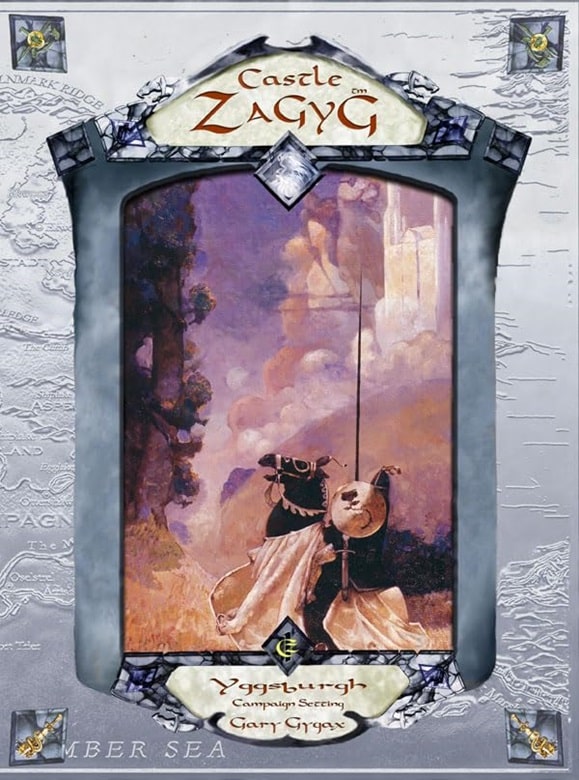
Gary Gygax’s Castle Zagyg: The East Mark Gazetteer, by Gary Gygax and Jeffrey Talanian (Troll Lord
Games, 2007), and Castle Zagyg Yggsburgh (Troll Lord Games, 2005). Cover art by Peter Bradley
It seems like yesterday, but it was nearly 18 years ago that Gary Gygax and Stephen Chenault were asking me if the first installment of the Castle Zagyg series, The Upper Works, would be done in time for Gen Con 07. I knew that it wouldn’t, so I suggested a pivot — something in the vein of the old Greyhawk Gazetteer.
I called it The East Mark Gazetteer, and I was grateful that Gary approved. Using content from Gary’s Yggsburgh hardback, some of Gary’s unused content, and modest contributions of my own, the EM Gazetteer was born, presented as from sages of Yggsburgh.
The project didn’t have much of a lifespan, the reasons for which I don’t care to get into, because it is now a moot point: The East Mark Gazetteer eventually became available at Humble Bundle, along with several other Gygax related works.
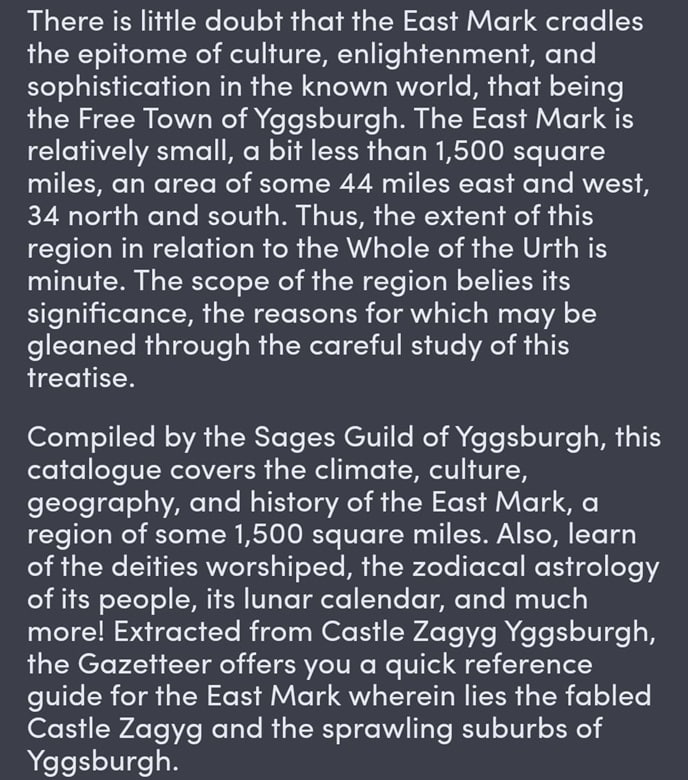 Ad copy for The East Mark Gazetteer
Ad copy for The East Mark Gazetteer
I am biased, of course, but I feel that CZ: EM alone was worth the price of admission. Reading the ad copy that I wrote for this work (above) brings me right back to those halcyon days, reminding me of my earlier works and the sheer delight it was to work for and with Gary Gygax.
Also offered in this bundle was a book that I coauthored with Luke Gygax, called The Trouble at Loch Jineeva. It’s a fun one (a TPK machine!) that I had a blast running for fellow gamers. Oh, also pictured above is my personal copy of The East Mark Gazetteer. Cheers!
Jeffrey P. Talanian’s last article for Black Gate was a look at B-List Heroes and More: Marvel Contest of Champions. He is the creator and publisher of the Hyperborea sword-and-sorcery and weird science-fantasy RPG from North Wind Adventures. He was the co-author, with E. Gary Gygax, of the Castle Zagyg releases, including several Yggsburgh city supplements, Castle Zagyg: The East Mark Gazetteer, and Castle Zagyg: The Upper Works. Read Gabe Gybing’s interview with Jeffrey here, and follow his latest projects on Facebook and at www.hyperborea.tv.
Jumping the Shark, Part III
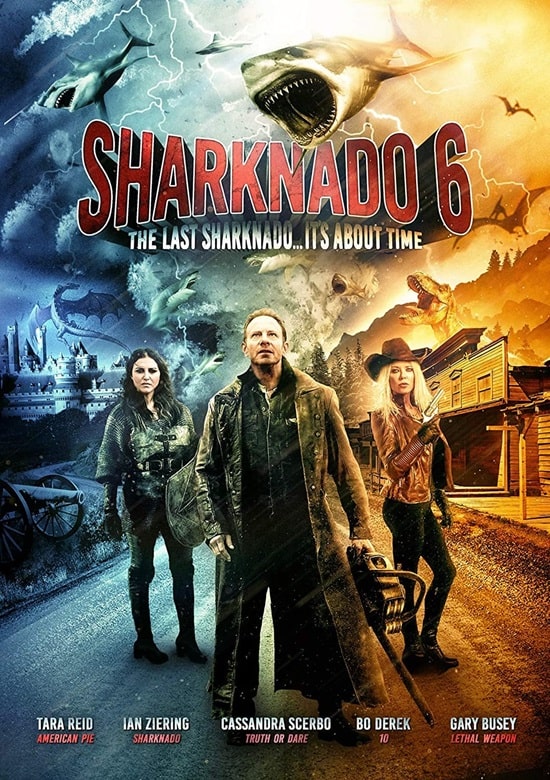
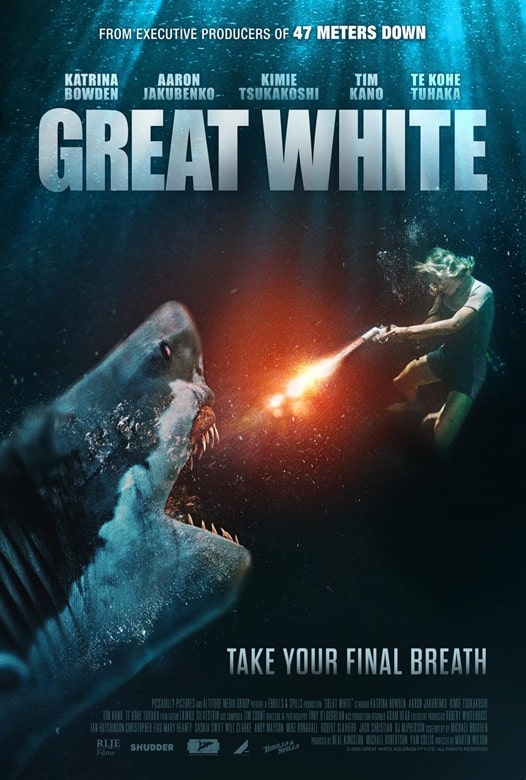
Sharknado 6: It’s About Time (The Asylum/Syfy Films, 2018), and Great White (Piccadilly Pictures, 2021)
So, here we go. A new watch-a-thon, this one based on a handful of the 500+ shark movies that I haven’t seen (or gave up on). I’m not holding out much hope for these — shark movies are, on the whole, awful, but I know for a fact that some of these are among the worst films ever made. This 20-film marathon is me just trying to understand why they get made, bought and streamed.
Sharknado 6: It’s About Time (2019) PrimeWhat kind of shark? Lots of CG sharks and some ropey dinosaurs.
How deep is the plot? 10 meters.
Anyone famous get eaten? Only beans. Hasbeans.
You can pretty much read my last review (for Sharknado 5) to get the gist of this one. This time, however, they decided against scraping the bottom of the D-lister barrel, and employed a couple of C-listers, with some E-listers scattered in for good measure.
It’s all very familiar, a nutzoid story littered with sub-par CG and plenty of scenery chewing, but it was still fun, and actually had a nice bit of timey-wimey plot paradox to prop up the proceedings. For the last in the series, it was surprisingly short on shark action, and the third act felt like it was written by a fourth-grader who has just tried coffee for the first time, but… eh… it’s a Sharknado film. Solid nonsense.
6/10
Great White (2021) ShudderWhat kind of shark? A refreshingly decent CG chonk.
How deep is the plot? 1 fathom.
Anyone famous get eaten? No.
We finish this 20-film movie masochism with Great White, a new film that explores the friendship between humans and film sharks. It’s really well shot, some lovely framing and cinematography, and the cast all do a great job, especially Katrina (Tucker & Dale) Bowden.
There’s nothing particularly earth-shattering about the script, and it’s certainly less fun than a couple of the titles on my list, but it’s nice to finish with a decent flick and without any risk of shark-induced coma.
Phew.
The Black Demon (Highland Film Group, 2023), and Under Paris (Let Me Be, 2024)
Extras The Black DemonIt was time for another shark flick, so I jumped on Prime for The Black Demon, made some popcorn, and settled in.
An ill-tempered megalodon — a creaky oil rig off the coast of Cancun — a family hiding secrets — grizzled Mexican oil workers — a gazpacho of body parts. It would be impossible to make this boring, right? Right?
The filmmakers: “ Hold our beer.”
Featuring Josh Lucas (the forgotten brother of Patrick Wilson and Bradley Cooper), the opportunity for an over the top chompy cheese-fest is squandered, drowned by a script that wants to investigate (and talk about) Mexican superstitions and family drama. The black demon barely eats anyone, and is hardly in the film at all.
I gave it a resounding ‘harumph’ at the end.
Don’t sleep on this one if you like shark flicks — it’s so refreshing to watch a non-crap shark movie these days, and I was pleasantly surprised at how this had a lovely slow build up, leaned into its sci-fi premise, and then went ABSOLUTELY BONKERS.
Meg 2: The Trench (Alibaba Pictures, 2023)
Meg 2: The TrenchAs good as the first film? Nope.
As bonkers as a squid on a unicycle? Yep.
Final judgement: Enjoyable, but if they get a third film there had better be more shark action. And a giant lobster.
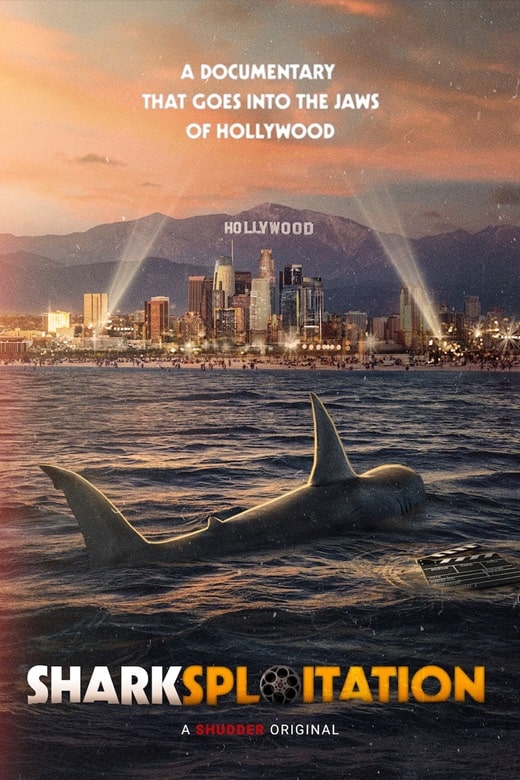
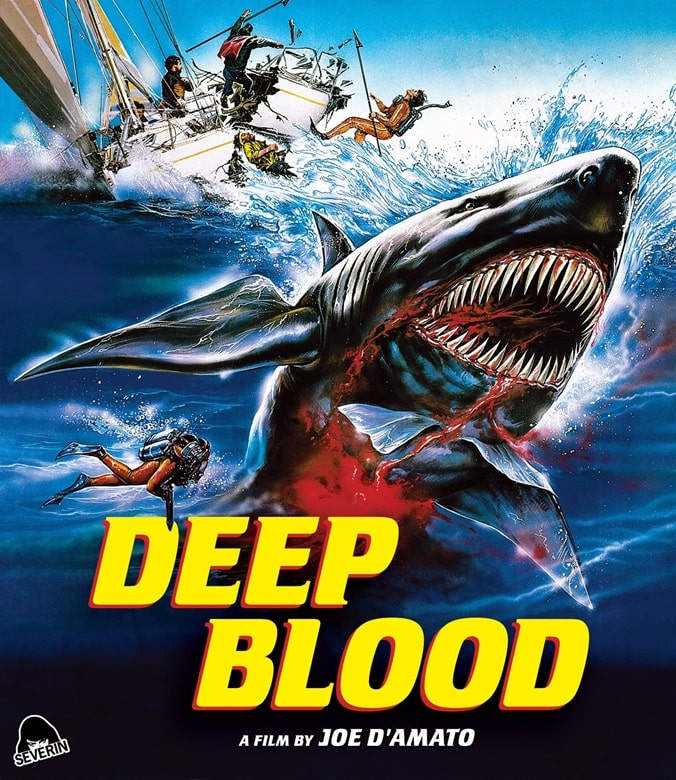
Sharksploitation (Shudder, 2023), and Deep Blood (Variety Distribution, 1989)
What’s better than a badly acted, poorly produced, bonkers shark movie?
A documentary about shark movies!
This is a decent watch as the filmmakers go to great lengths to explain the legacy of Jaws and why the shark movie endures. Lots of great talking heads and some fun clips of good and bad (and downright terrible) movies.
If I had to gripe, it would be that I would have preferred if they’d spent about 10 mins less time talking about shark conservation, and used those 10 mins for a deeper dive into the weirder films out there.
That said, it harbors a worthwhile message about shark preservation. Check it out on Prime (Shudder or AMC+)
Deep BloodAnother shark movie crossed off the list. Deep Blood from 1989 differs from Jaws in that it has a wholly unnecessary subplot involving an ancient Native American curse. The subplot has absolutely no impact whatsoever on the story, the shark is all stock footage, and this film has the distinction of being one of the most boring films I have ever watched.
Recommended.
Shark Bait (Picaro Films, 2022)
Shark BaitShark Bait (Tubi) brings nothing new to the table. A bunch of unlikeable spring breakers drunkenly ‘borrow’ some jet skis, and end up in a bit of a kerfuffle when they smash them up in the middle of the ocean. To compound matters, there’s a grumpy great white in the water who apparently hates jet skis. People get eaten, final girl is plucky and resourceful, yada yada.
It’s all a bit dour, but the makeup effects are decent and the CG shark looks good when it stays in the brine. It’s OK if you’re a sharksploitation completist.
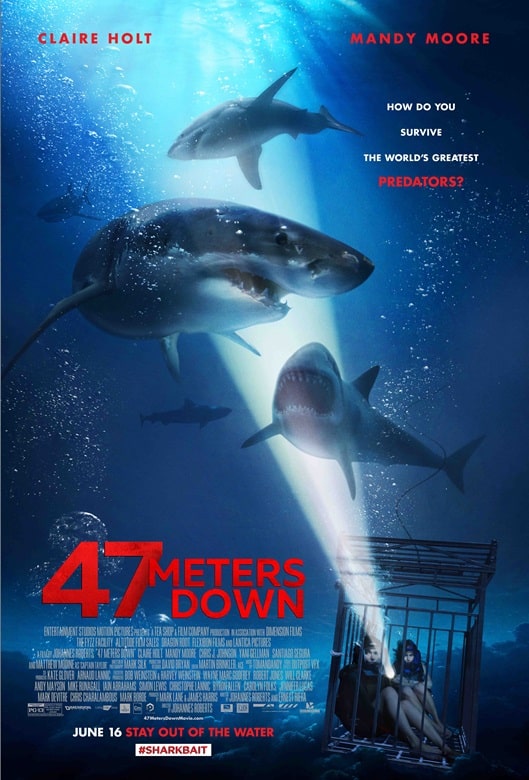
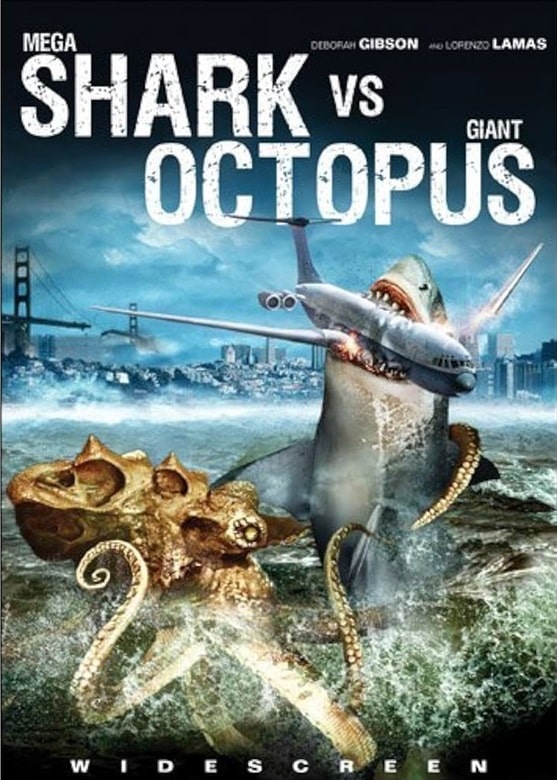
47 Meters Down (Dimension Films, 2017), and Mega-Shark vs. Giant Octopus (The Asylum, 2009)
Couldn’t sleep one night and ended up sleep-watching 47 Meters Down, which was excellent. Basically, sisters on hols, fell asleep, sisters in shark cage on boat, fell asleep, sisters in shark cage 47 meters down, fell asleep, shark-based kerfuffle, fell asleep, end credits. By all accounts, it is a decent flick and I must watch it awake.
Mega-Shark vs. Giant OctopusJust had the last ounce of pleasure drained from watching SyFy movies with Mega-Shark vs. Giant Octopus. Now these movies are just ‘guilty’.
Previous Murkey Movie surveys from Neil Baker include:
Jumping the Shark, Part I
Jumping the Shark, Part II
Alien Overlords
Biggus Footus
I Like Big Bugs and I Cannot Lie
The Weird, Weird West
Warrior Women Watch-a-thon
Neil Baker’s last article for us was Jumping the Shark, Part II. Neil spends his days watching dodgy movies, most of them terrible, in the hope that you might be inspired to watch them too. He is often asked why he doesn’t watch ‘proper’ films, and he honestly doesn’t have a good answer. He is an author, illustrator, outdoor educator and owner of April Moon Books (AprilMoonBooks.com).



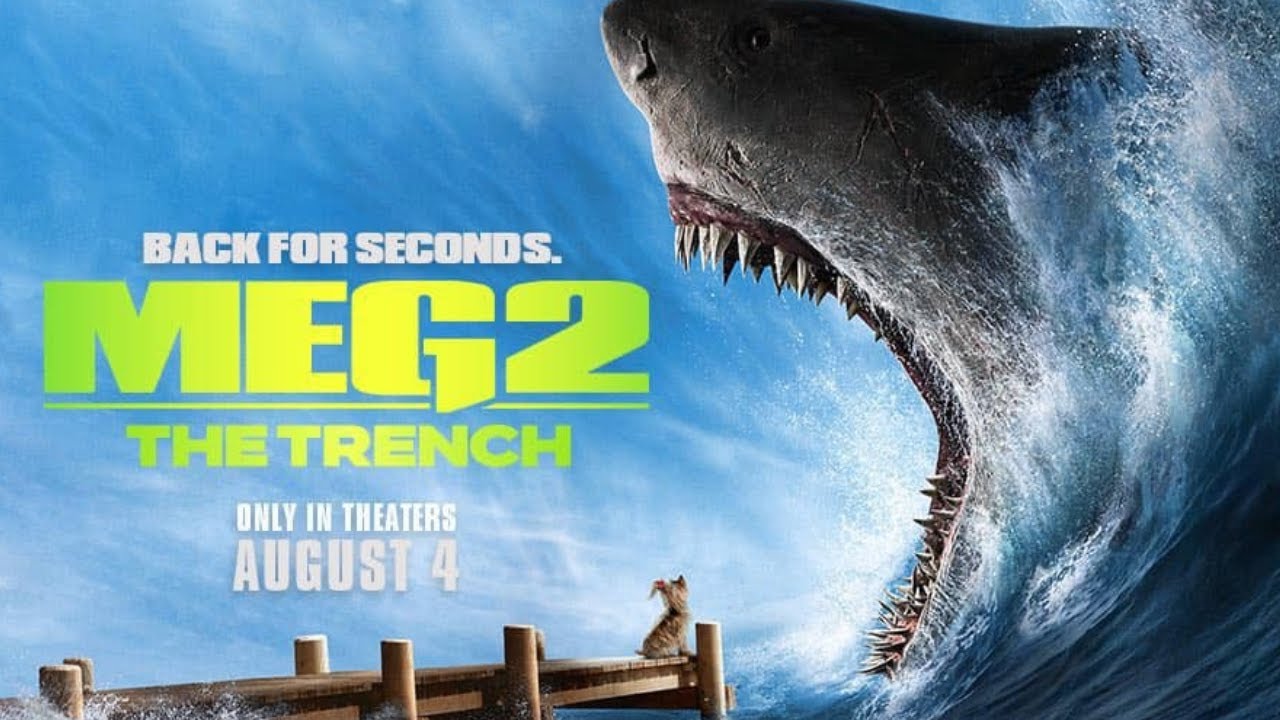

Recent comments